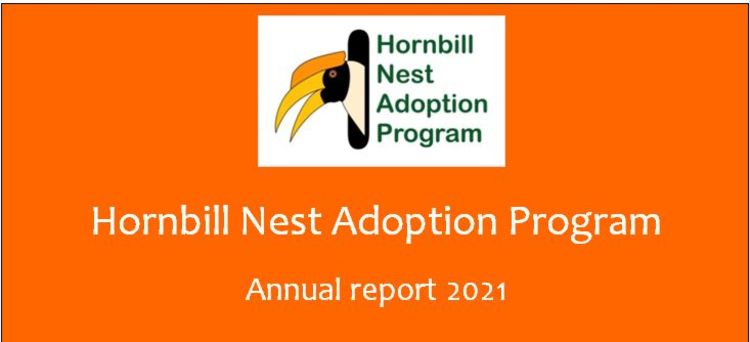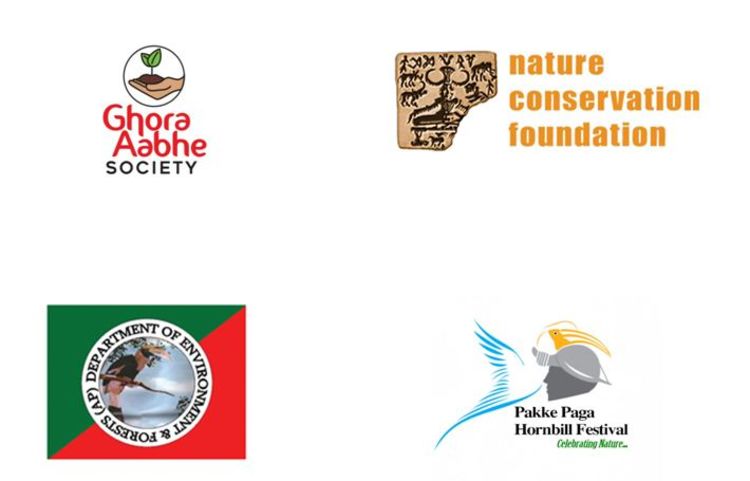HORNBILL NEST ADOPTION PROGRAM
Annual Report 2021
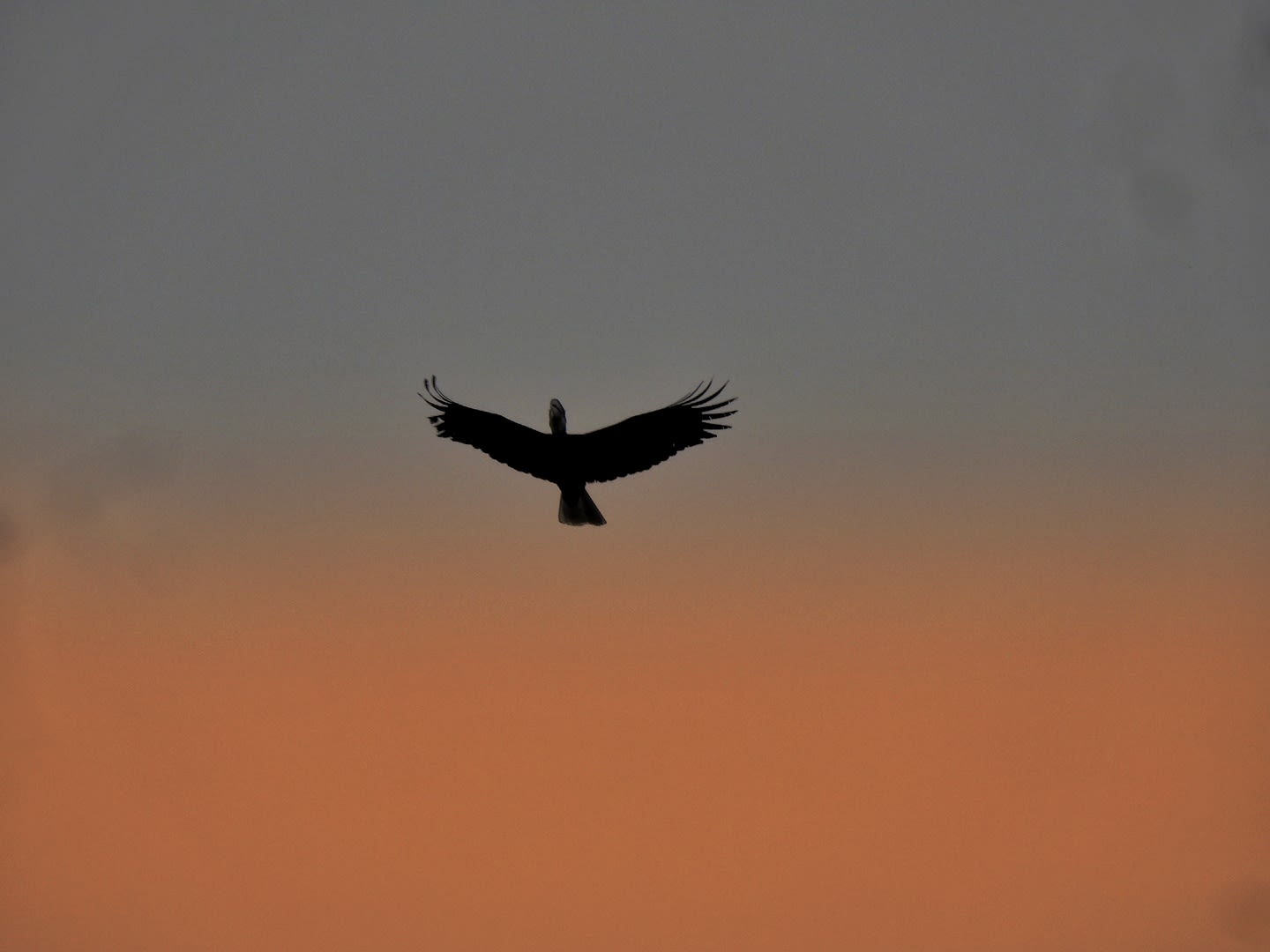
Saving hornbill homes with communities
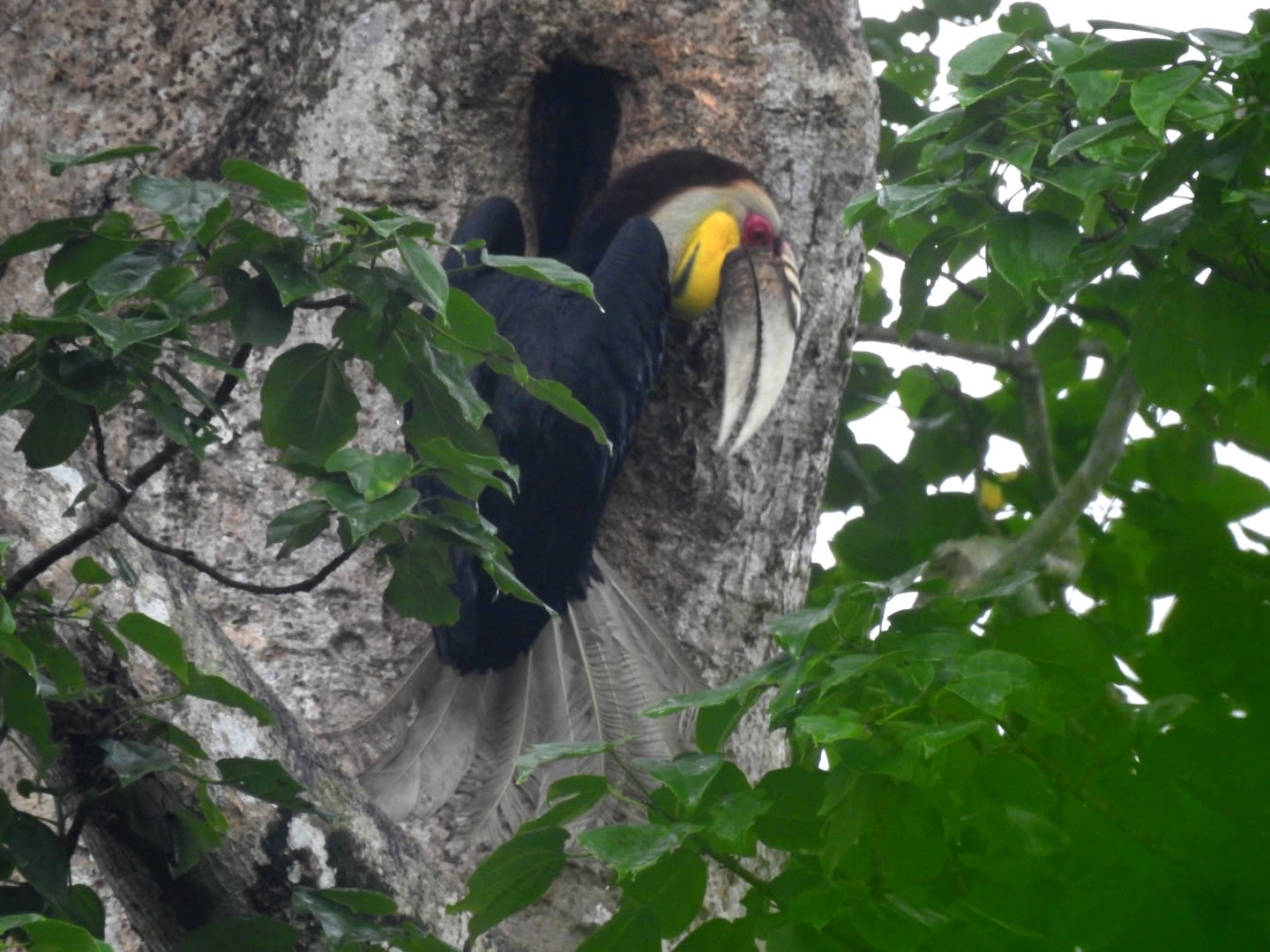
The Hornbill Nest Adoption Program (HNAP) completes 10 years of dedicated community-based hornbill conservation in the forests outside the Pakke Tiger Reserve in Arunachal Pradesh.
Officially launched in 2012, the Hornbill Nest Adoption Program started as a three-way partnership between the Forest Department and ‘Ghora-Aabhe Society’, and Nature Conservation Foundation. The idea was to create a synergy between the management, scientific community and local partners to protect hornbills and their habitat in this landscape.
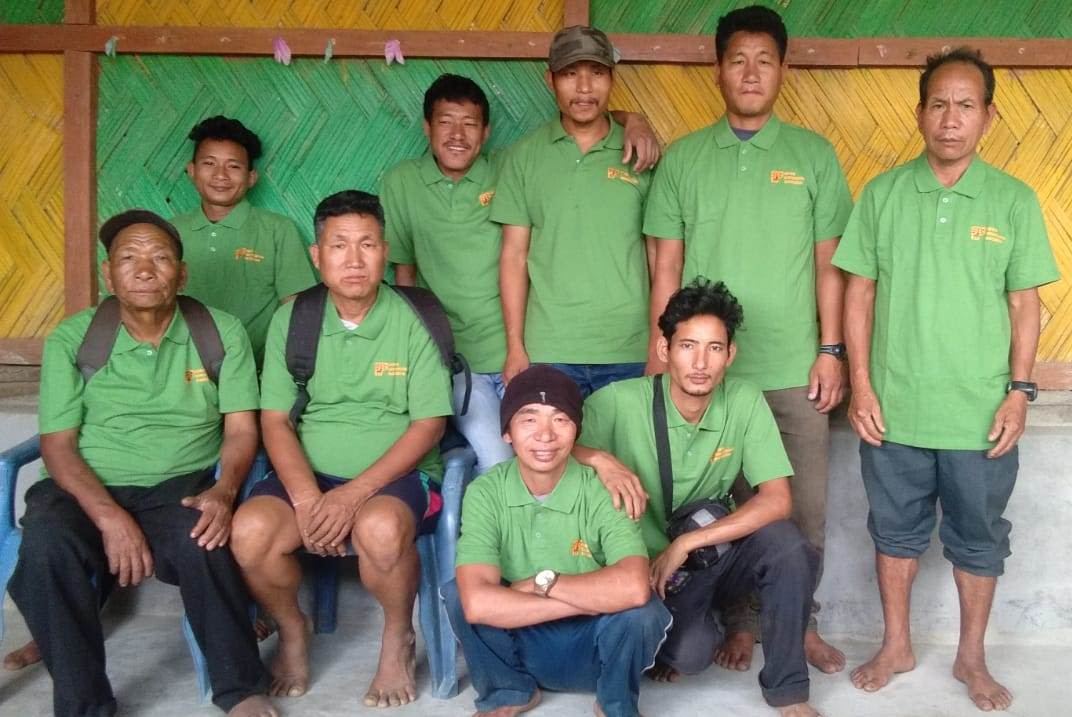
The " Nest Protectors" who are members of the Nyishi community have been the backbone of this 10-year long program. The various skills developed by the nest protectors over the years have helped in documenting critical information on hornbill nesting from the forests outside Pakke TR, even during the pandemic, when most field work was halted.
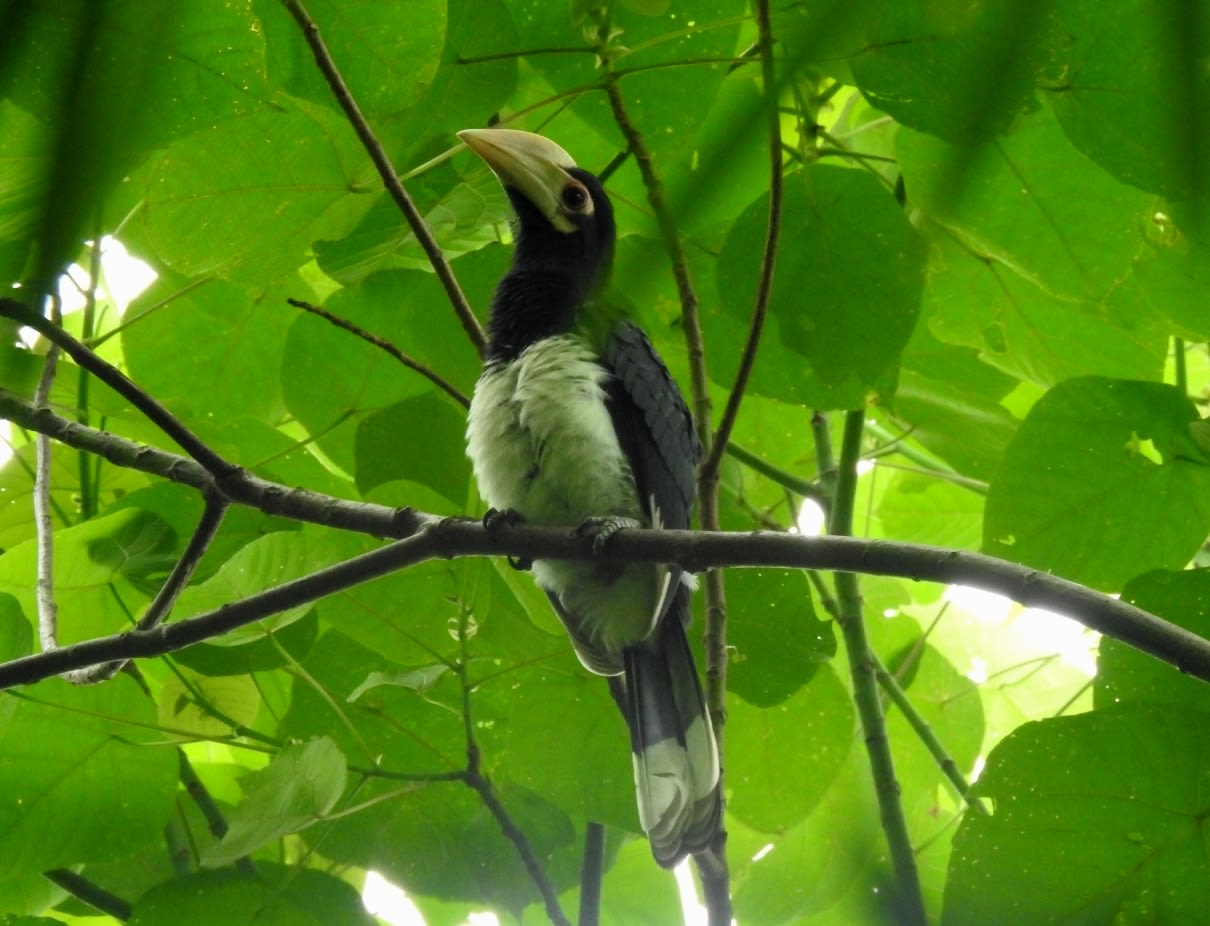
In this 2021 annual report, we share the news from the Hornbill Nest Adoption Program of the year's activities and findings. We have also included updates from our other program work which includes rainforest restoration, the nature education program and the expansion of hornbill research and conservation in Assam and north Bengal.
Content
- A decade of protecting hornbills
- Highlights of HNAP over the decade
- Nest monitoring in Papum Reserved Forest 2021
- Nesting summary in Papum Reserved Forest 2021
- Hornbill roosting
- A story about saving hornbill nesting trees
- Spot what's unusual in the photograph!
- Adopt a hornbill nest : HNAP donation details and a photo print sale
- Nest monitoring in Pakke and Nameri Tiger Reserves, 2021
- Rainforest restoration in the Pakke landscape
- Tropical rainforest restoration workshop
- Nature Education Program
- Hornbill research and conservation in Buxa Tiger Reserve, West Bengal
- Hornbill research and conservation in Upper Assam
- Covid relief work in the North-east
- Annual accounts statement
- Acknowledgements
- Hornbill parents
- Publications
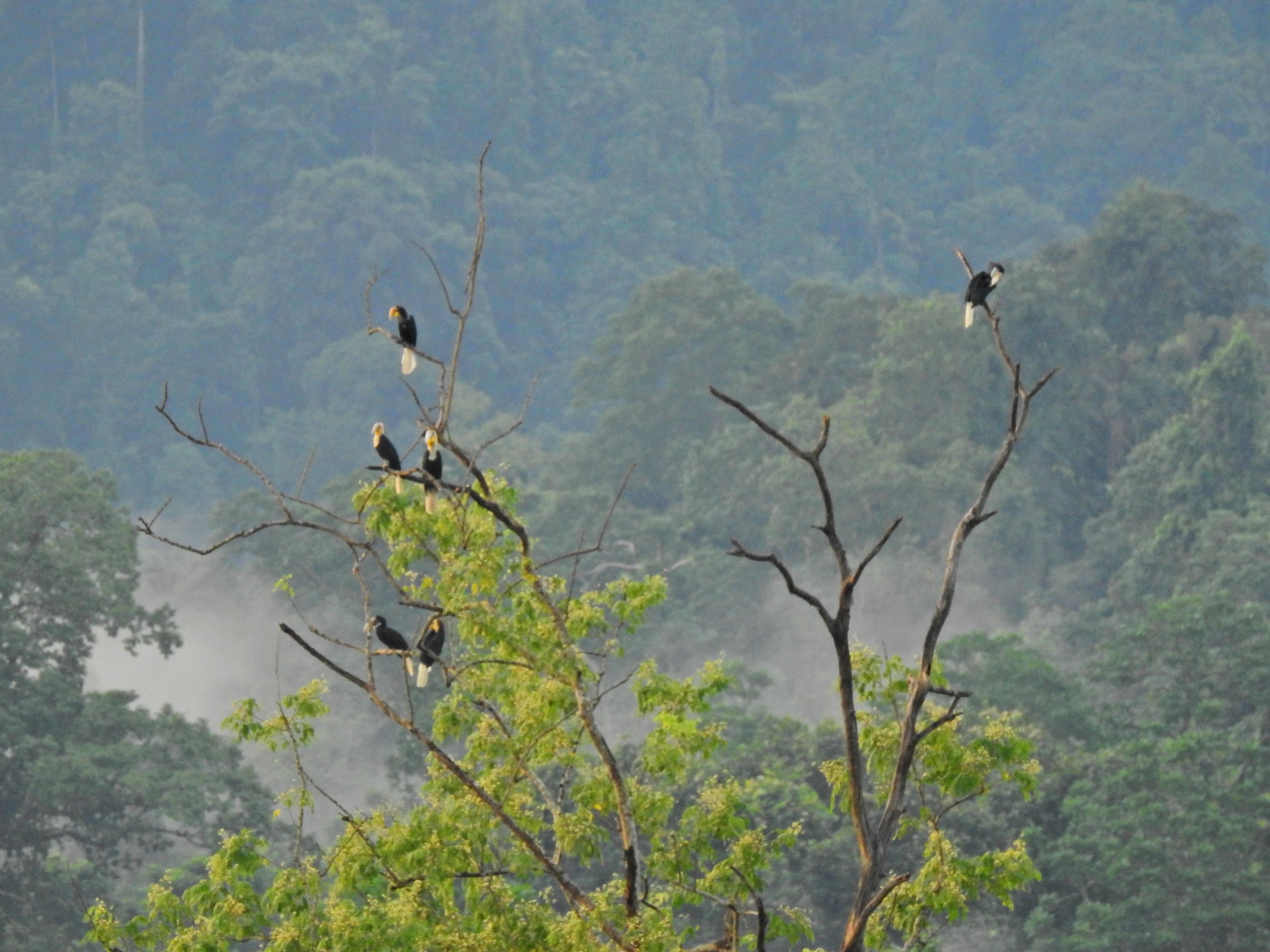
A decade of protecting hornbills
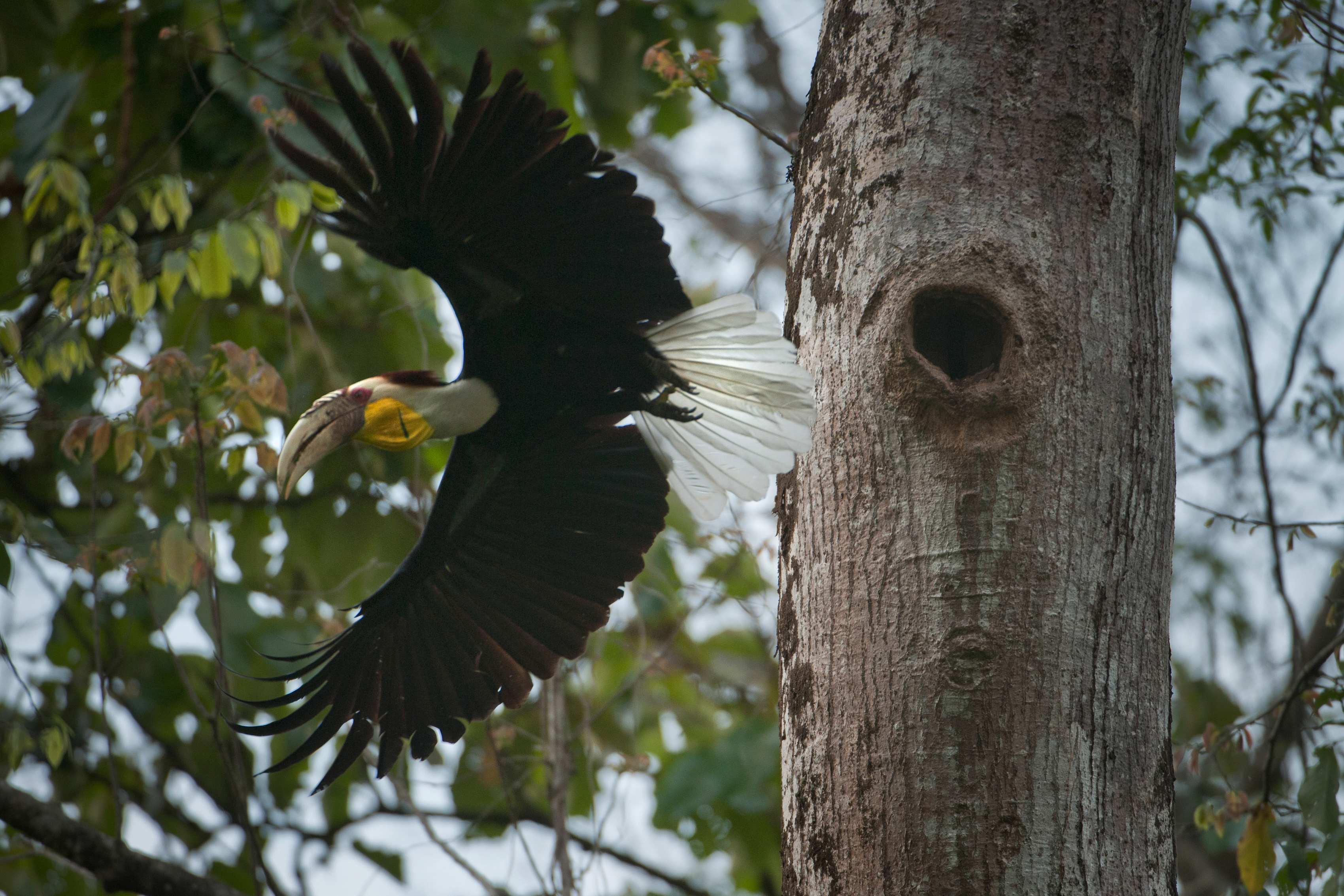
The Pakke Tiger Reserve and the adjoining Reserve Forests of Khellong Forest Division harbour 4 species of hornbills (Great, Wreathed, Oriental Pied and Rufous-necked hornbill) which are listed in Schedule 1 of the Wildlife Protection Act (1972).
Following a research and conservation program of the Eastern Himalaya Program of the Nature Conservation Foundation (NCF) since 2003, it was observed that the adjoining low-elevation forests outside Pakke were being affected by degradation and loss of forest habitat.
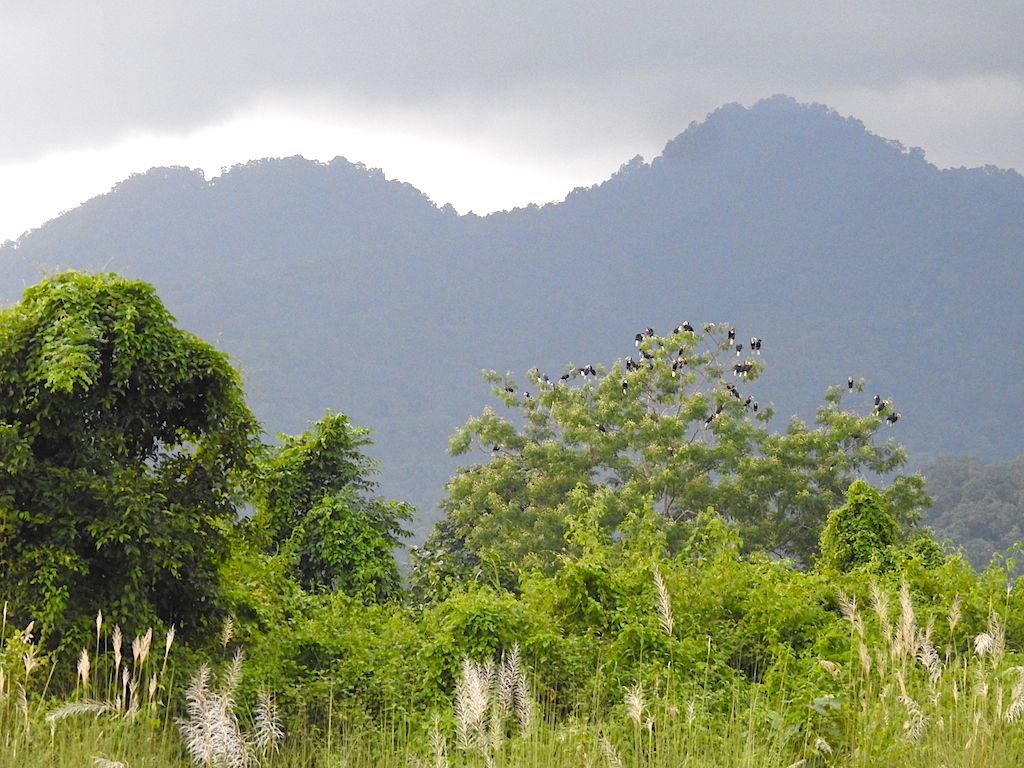
Hornbills arrive to roost in large numbers close to the settlements
Hornbills arrive to roost in large numbers close to the settlements
Hornbills being large, mobile birds require large tracts of suitable habitats to sustain their population and use both the park and the adjoining forests. Therefore, protection and conservation of habitat for hornbills needs to be done over larger areas, and for doing so, it was important to work with local communities and other stakeholders.

With this intent, NCF along with a local NGO - the Ghora-Aabhe Society and the Forest Department initiated the “Hornbill Nest Adoption Program” (HNAP) in 2011. The program was officially launched in the 2012 hornbill breeding season. In 2017, the Pakke Paga Hornbill Festival Committee was included as a fourth partner.
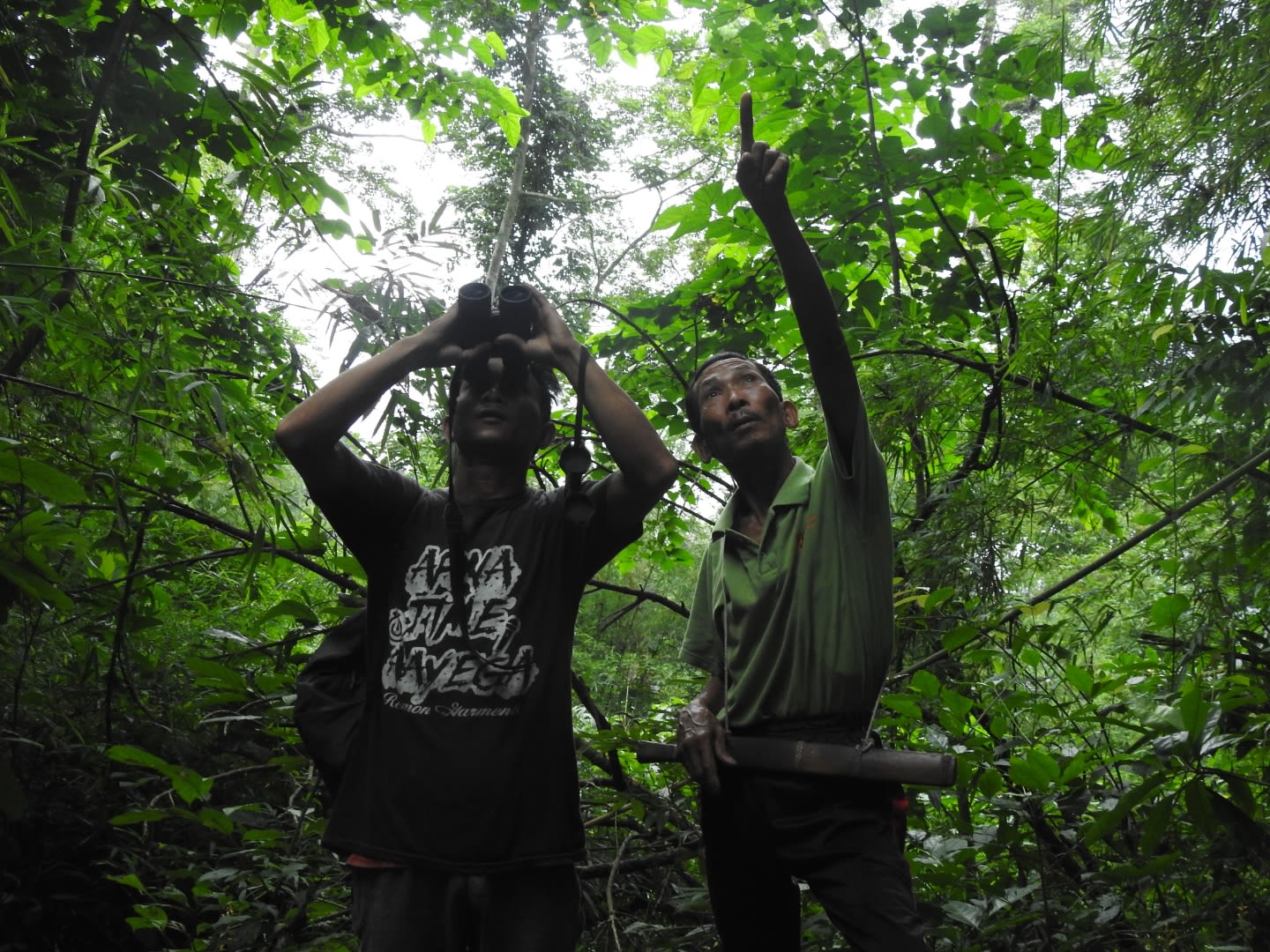
Prem and Nikje spot some activity in one of the active hornbill nest trees
Prem and Nikje spot some activity in one of the active hornbill nest trees
A decade after the program was initiated, 11 local Nyishi members continue to roam the forests looking out for hornbills, guarding over their nest trees and spreading the message of conservation in their villages.
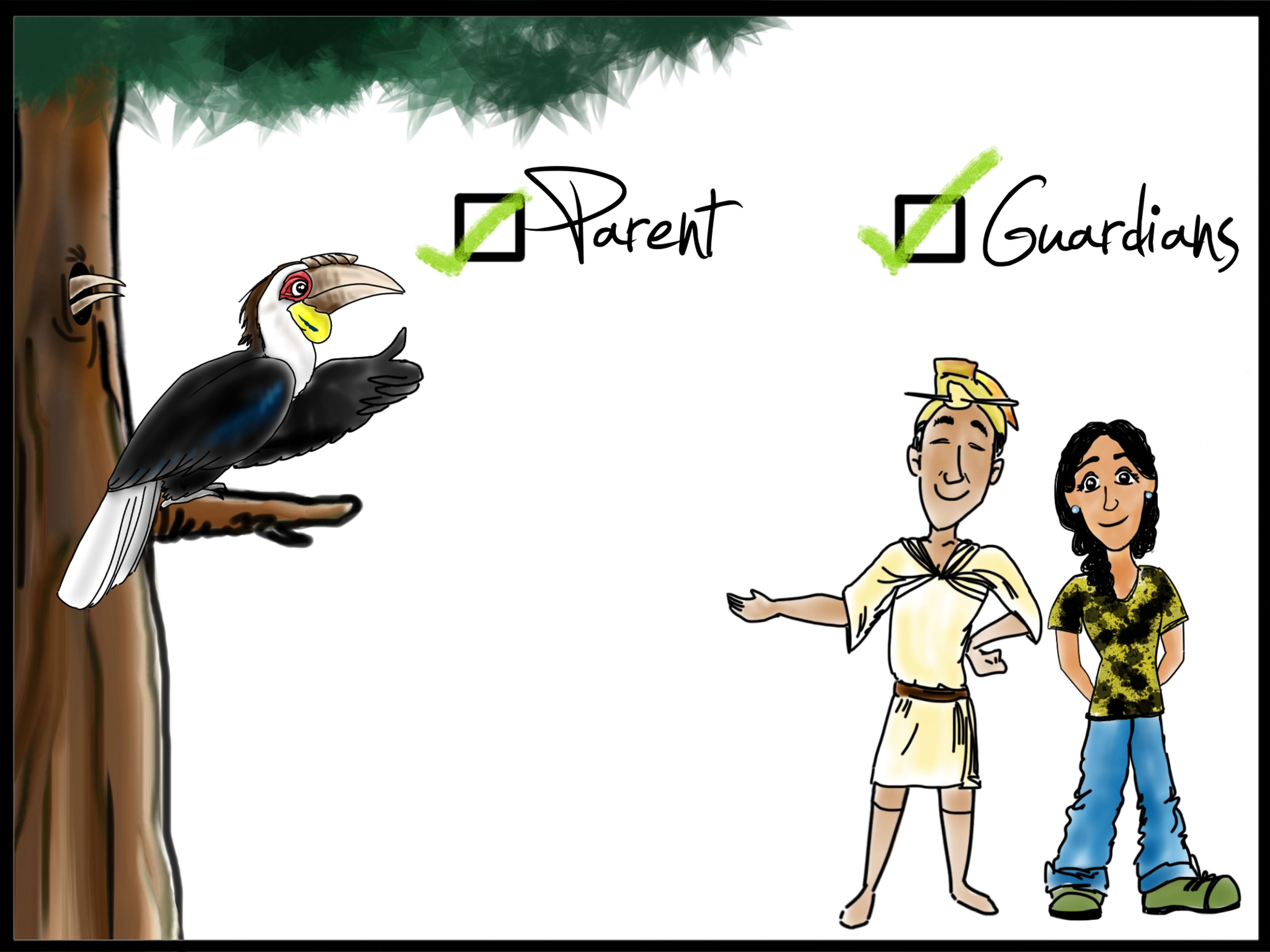
The Hornbill Nest Adoption Program (HNAP) is a long-running community-based conservation program, possibly among few such models in the country. This model that is based on the concept of "shared parenting" has brought together multiple key stakeholder groups for protecting threatened species and their habitat and provided a source of livelihood to over 21 nest protectors till date.
The biggest achievement of this decade long program has been the successful recorded fledging of 173 hornbill chicks of three hornbill species – Great hornbill, Wreathed hornbill and Oriental Pied hornbill.
To know more:
Films:
"On The Brink" series featuring the Hornbill Nest Adoption Program (HNAP)
Podcast: The Allure And Majesty Of Hornbills With Dr. Aparajita Datta

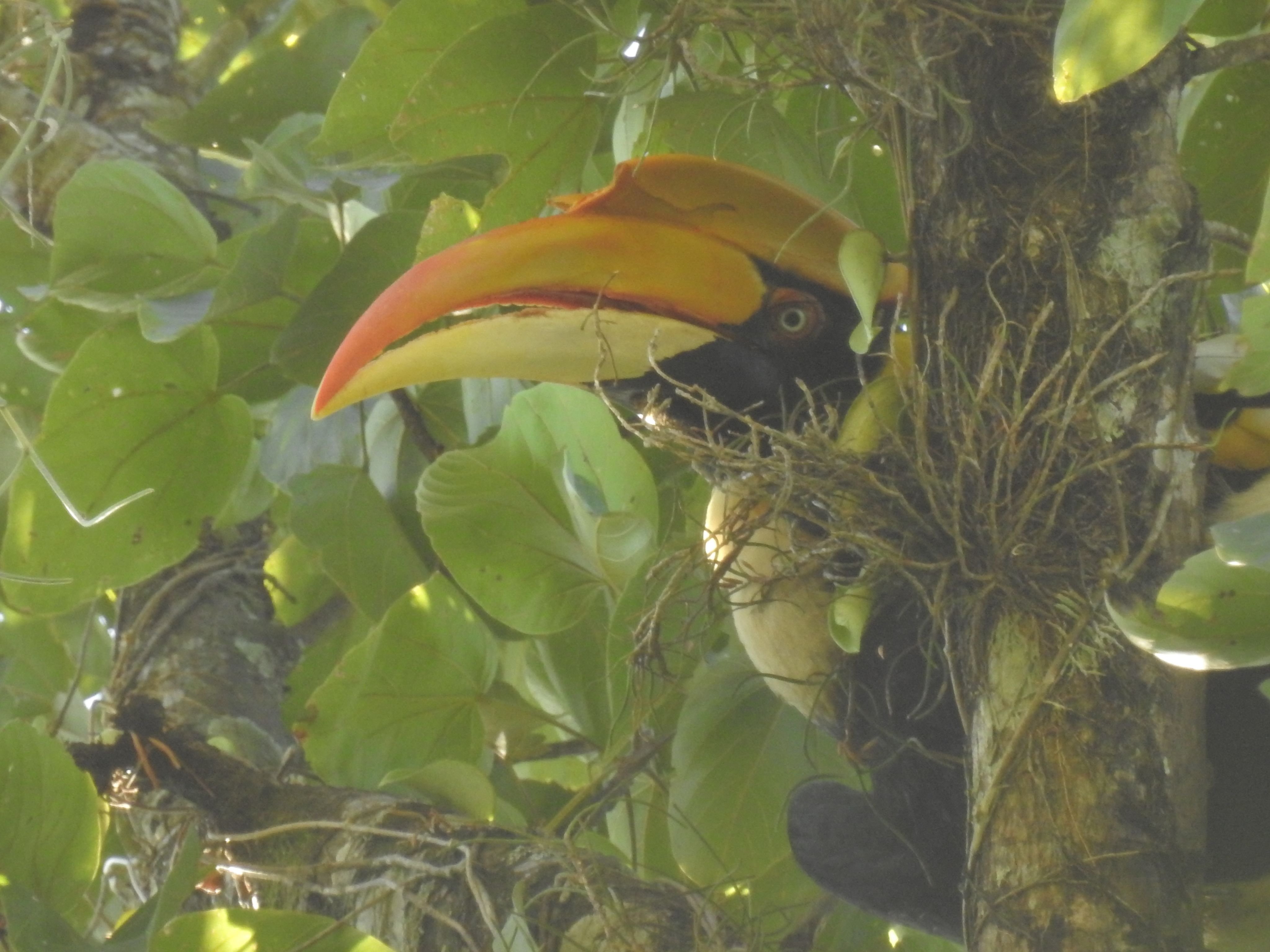
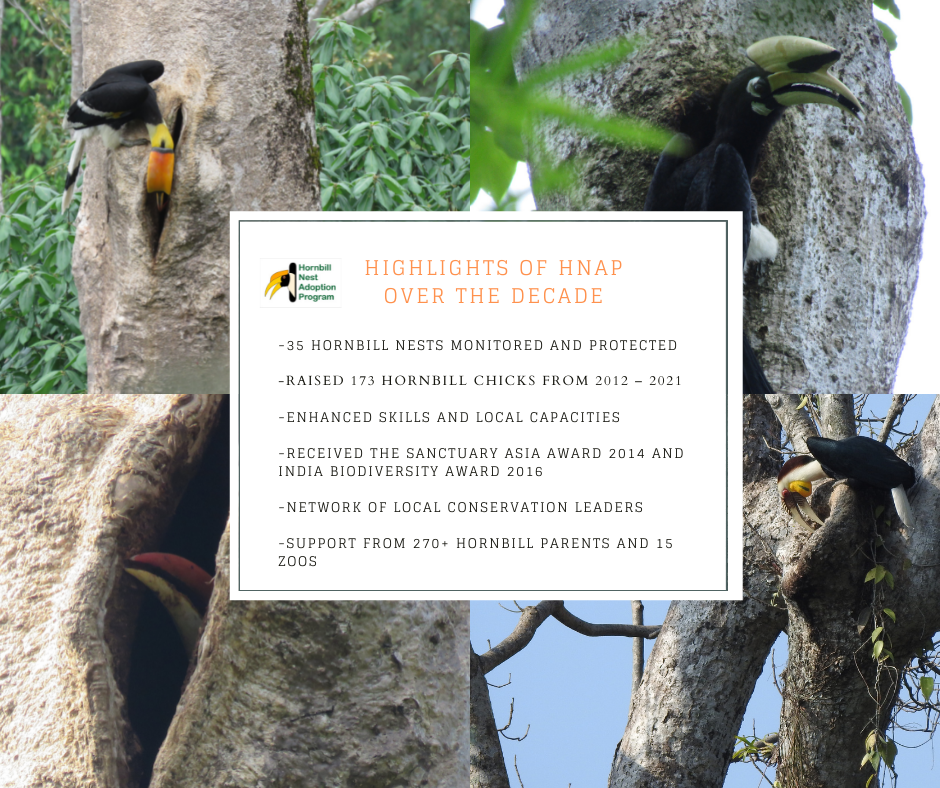
Nesting update 2021
Papum Reserved Forest
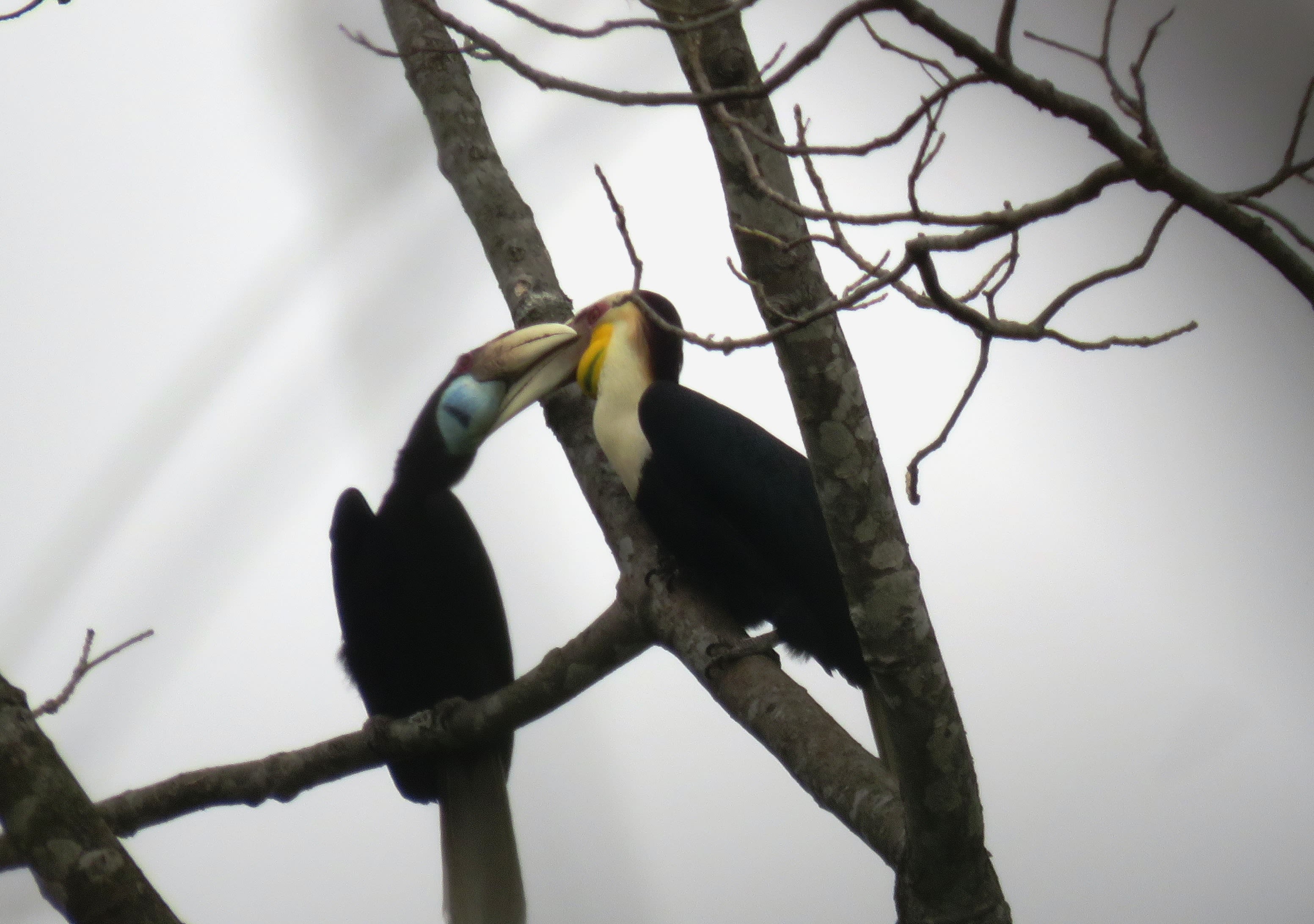
A Wreathed hornbill pair at the onset of the breeding season
The hornbill breeding season is a very exciting period for us. For the hornbills, though, it is a vulnerable period as the female imprisons herself inside a cavity for 3-4 months until the chick is healthy and ready to fledge. The male hornbill plays a critical role bringing food for the female and the chick(s) to meet their nutritional requirement, while also feeding himself.
The breeding period also engages the hornbill nest protectors who take up the role of local guardians and help in protecting occupied hornbill nests from any human-induced disturbances. They make critical observations at each nest and contribute to a long-term understanding of hornbill breeding and changes in nesting patterns in this area.
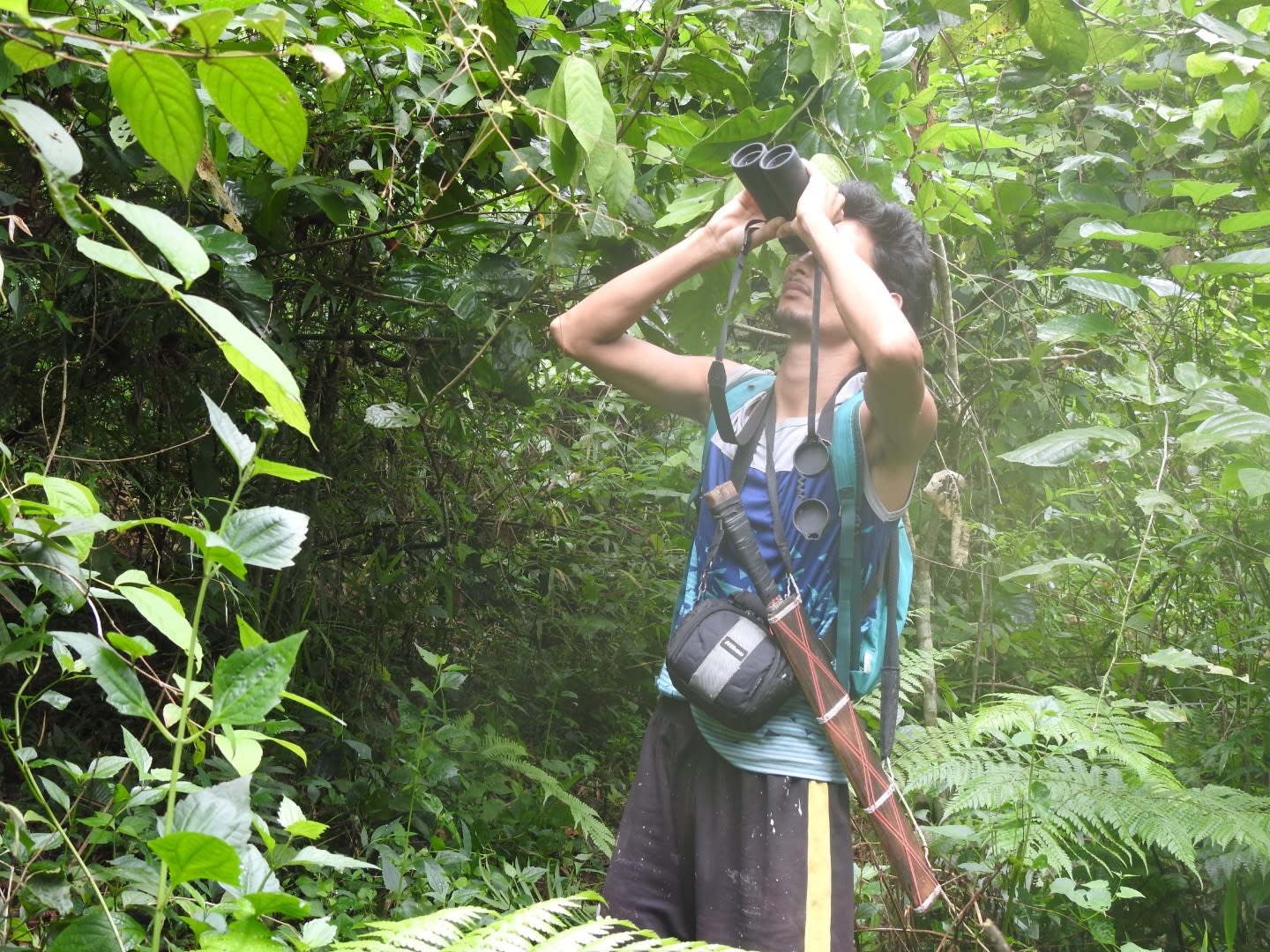
Taring observes activity at a Wreathed hornbill nest
This year, the nest protectors monitored 29 hornbill nests in the breeding season. Out of them, 20 nests were occupied by breeding hornbills and were reported to be “active”.
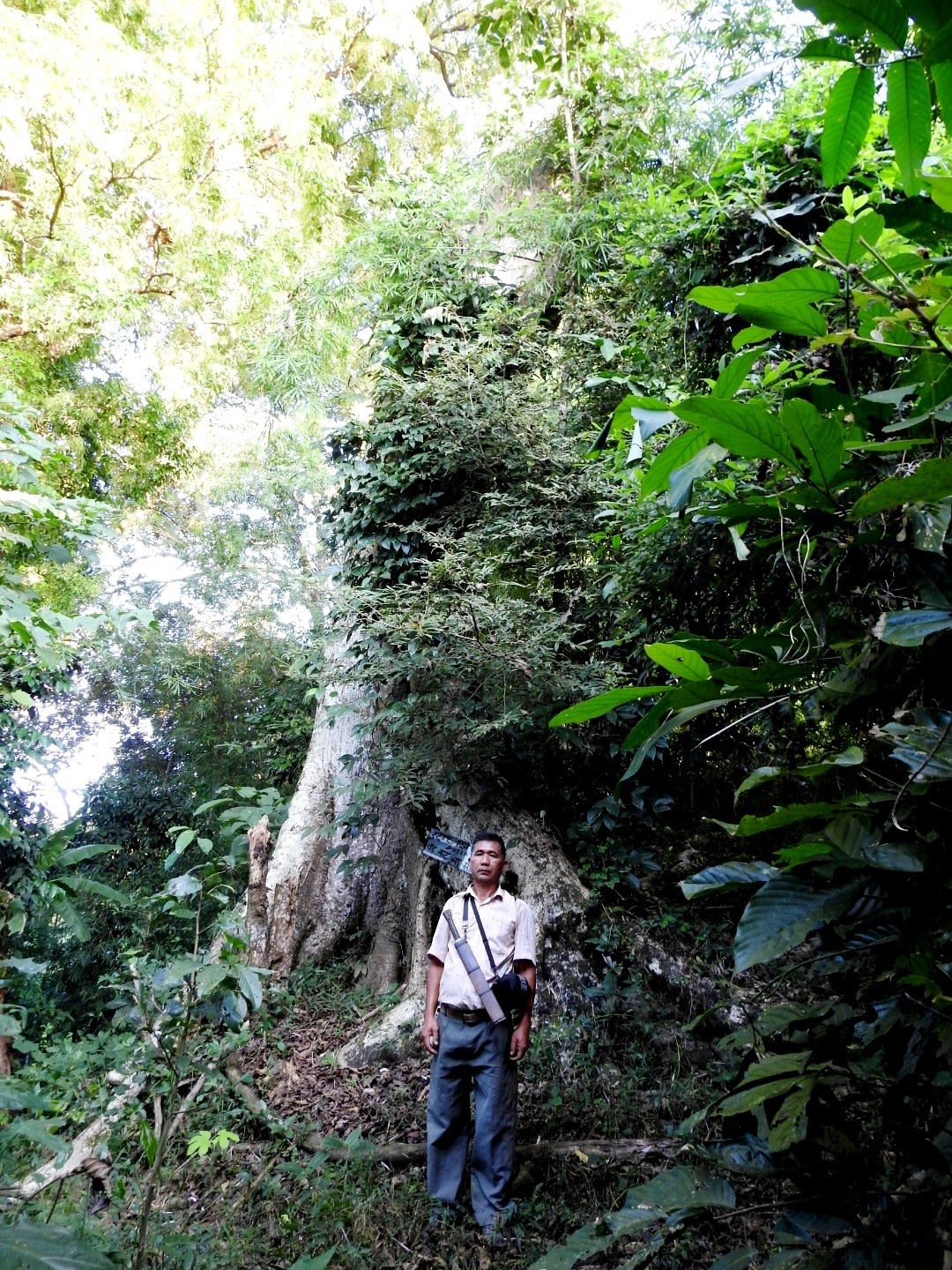
Budhiram Tai, one of the oldest nest protectors of the HNAP, stands in front of the nest tree he monitors every year
The 20 nests were visited periodically by the nest protectors. At the end of the breeding cycle, the team confirmed successful fledging in 18 of the 20 nests. Two nests were abandoned mid-season for unknown reasons.
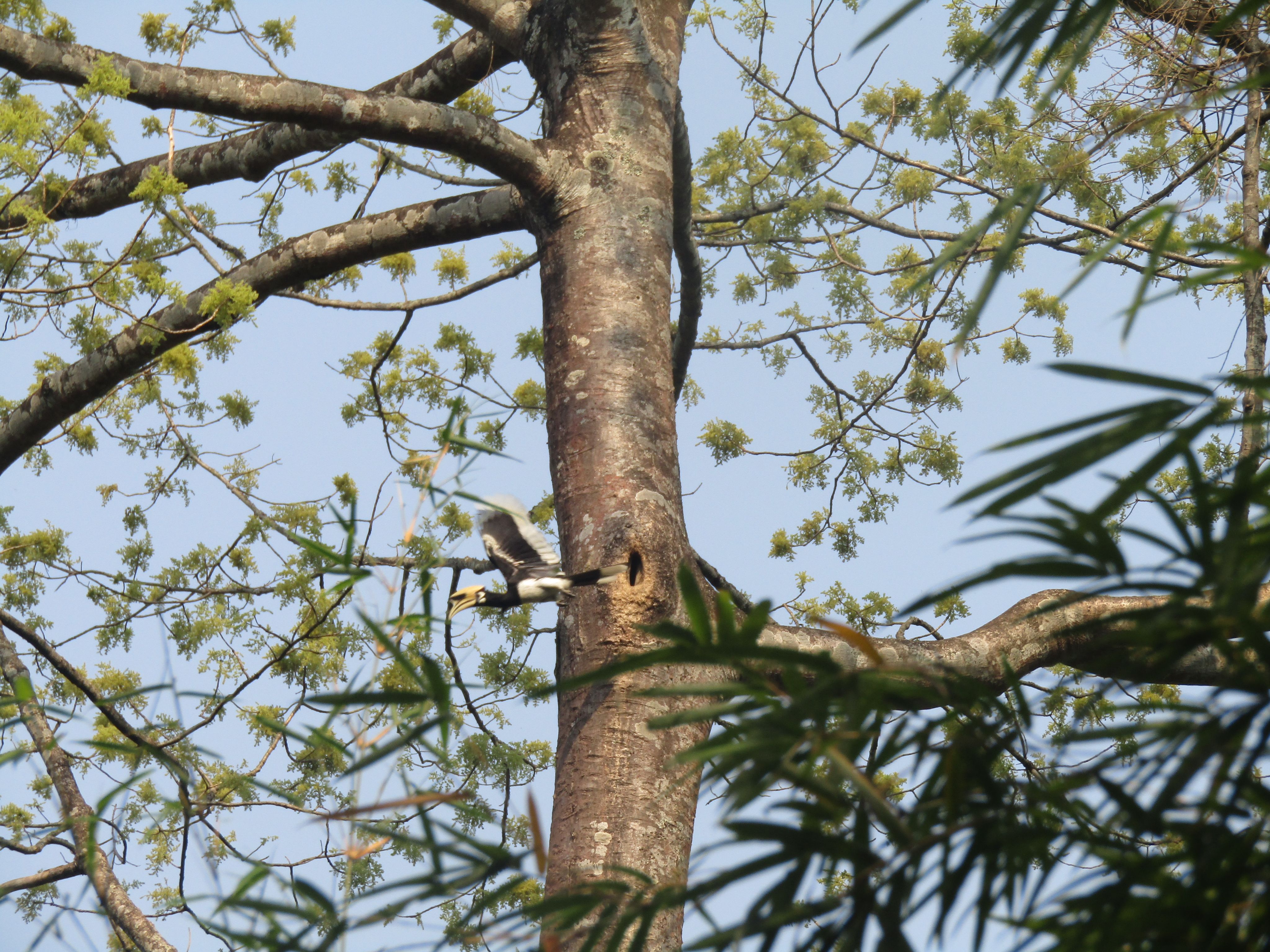
An Oriental Pied hornbill flies away after a feeding visit at the nest
The nesting success for this year was 90%, which is remarkable given that this part of the landscape falls outside the formally protected areas.

A Wreathed hornbill pair at the onset of the breeding season
A Wreathed hornbill pair at the onset of the breeding season

Taring observes activity at a Wreathed hornbill nest
Taring observes activity at a Wreathed hornbill nest

An Oriental Pied hornbill flies away after a feeding visit at the nest
An Oriental Pied hornbill flies away after a feeding visit at the nest

Budhiram Tai, one of the oldest nest protectors of the HNAP, stands in front of the nest tree he monitors every year
Budhiram Tai, one of the oldest nest protectors of the HNAP, stands in front of the nest tree he monitors every year
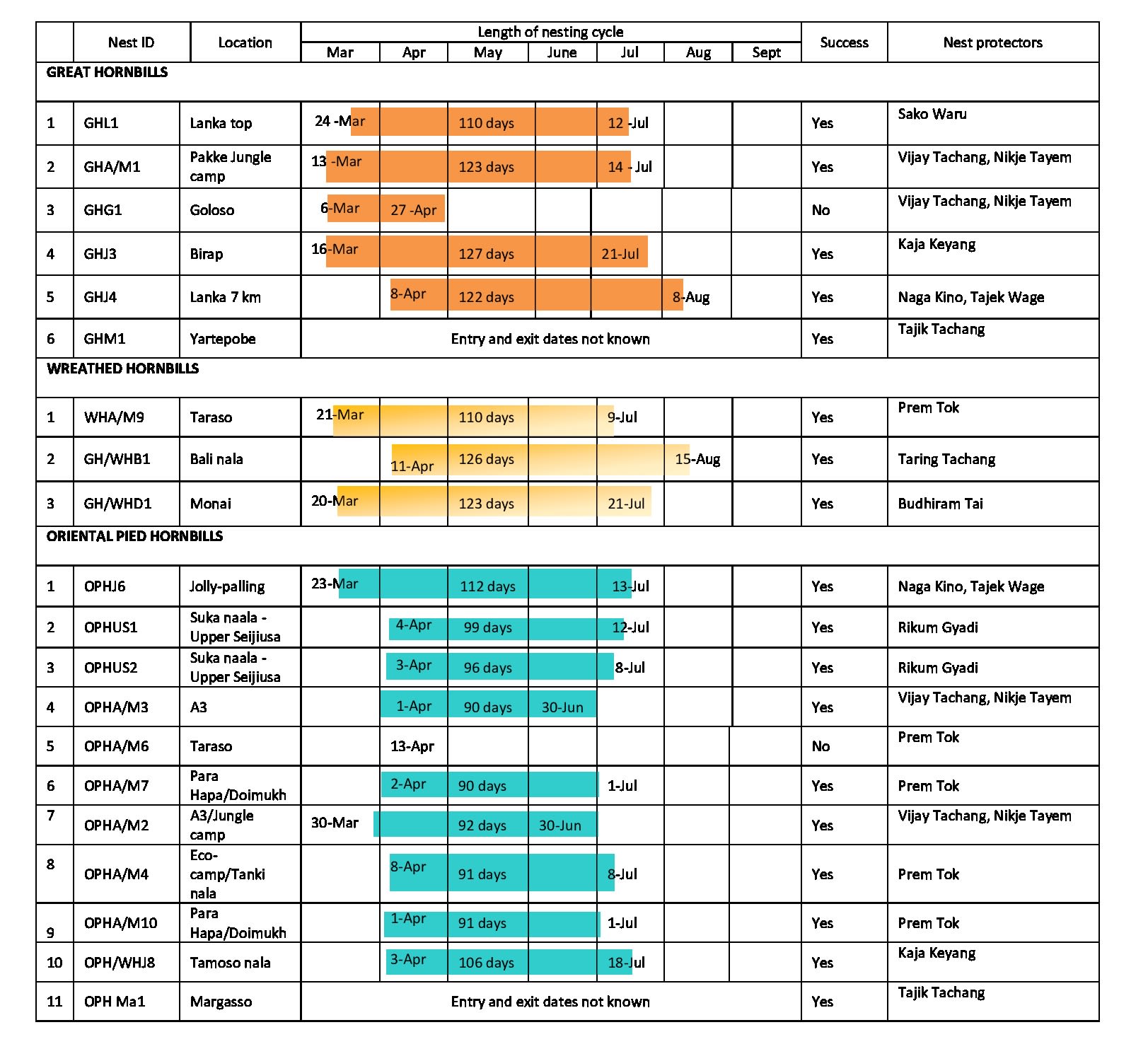
Summary of the active nests in the Papum Reserved Forest, Arunachal Pradesh
Summary of the active nests in the Papum Reserved Forest, Arunachal Pradesh
The nest protectors also monitored 19 hornbill roosting sites near villages along the Pakke river on the southern boundary of the Pakke Tiger Reserve from October 2020 to September 2021.
Out of a total of 318 observation days at 11 sites, Wreathed hornbills were seen on 290 days (91%) from Oct 2020 to Sept 2021. Out of these 11 sites that were monitored, Wreathed hornbills were observed in eight sites.
The number of Wreathed hornbills visiting these eight roost sites varied from 1-59 individuals.
Out of 361 observation days at 17 sites, Oriental Pied hornbills were seen on 237 days (65%) from Oct 2020 to Sept 2021. Twelve out of these 17 sites are being used for roosting by the Oriental Pied hornbill (OPH).
The number of Oriental Pied hornbills observed at these sites ranged from 1-20 individuals
All heroes don’t wear capes
In the middle of the breeding season this year, we started receiving frantic calls from Prem Tok, the youngest and an extremely motivated nest protector who has been associated with the Hornbill Nest Adoption Program since 2016.
When he was on a monitoring visit, he noticed a few men who had come to cut trees near two active hornbill nest trees. After approaching and informing them of the nest trees, the men eventually left the area.
But, Prem was not convinced. He left for Tajik's house. Tajik is the local co-ordinator of the HNAP. The following day, Tajik went to the village adjoining the forest where the incident had occurred.
He had a dialogue with the local members and explained the importance of these nesting trees and the overall habitat for hornbills. We were later informed that the men had left the area.
We are happy to share that both the nests had successful chick fledging, thanks to the timely intervention of the nest protector and the local co-ordinator.
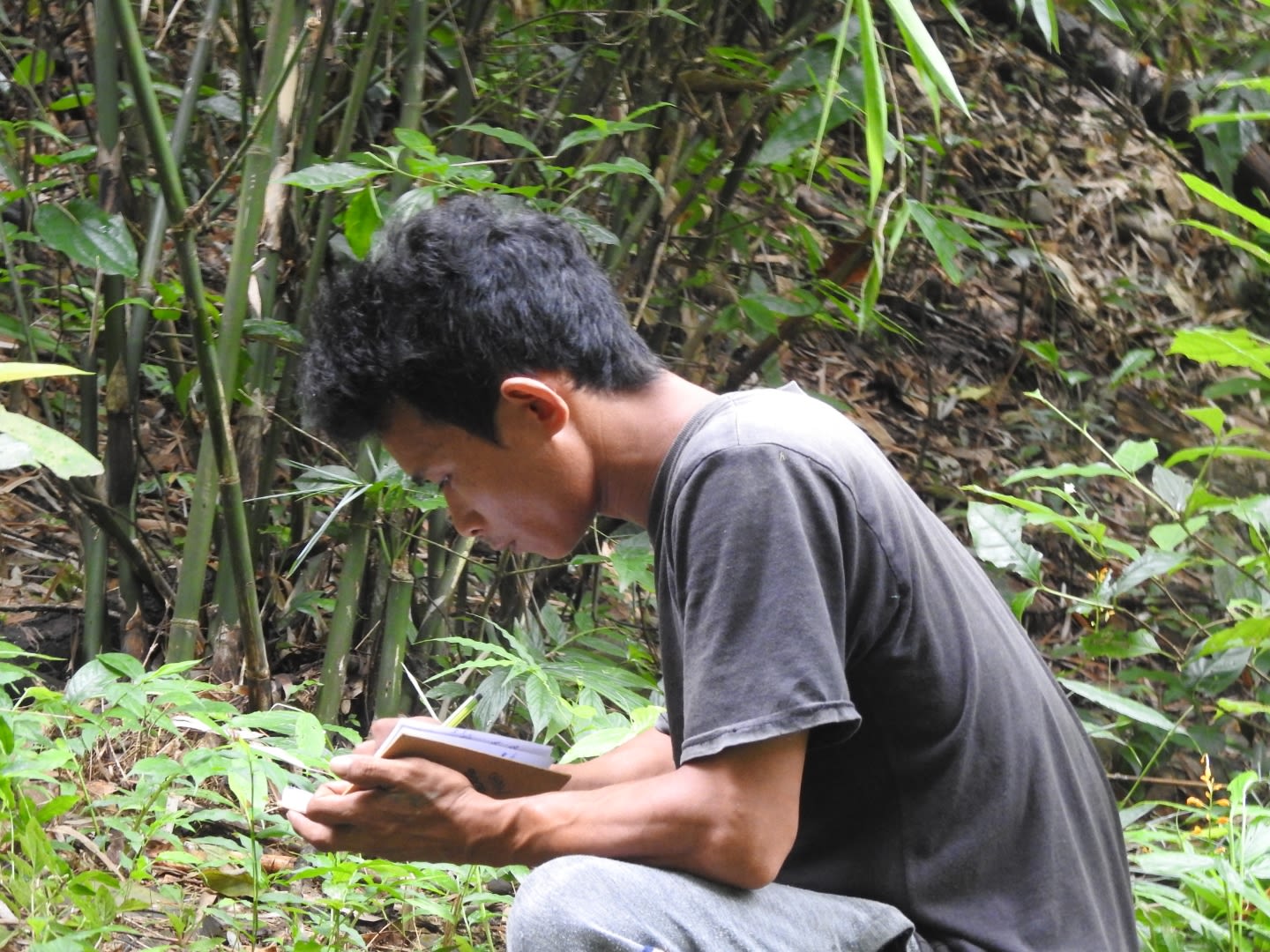
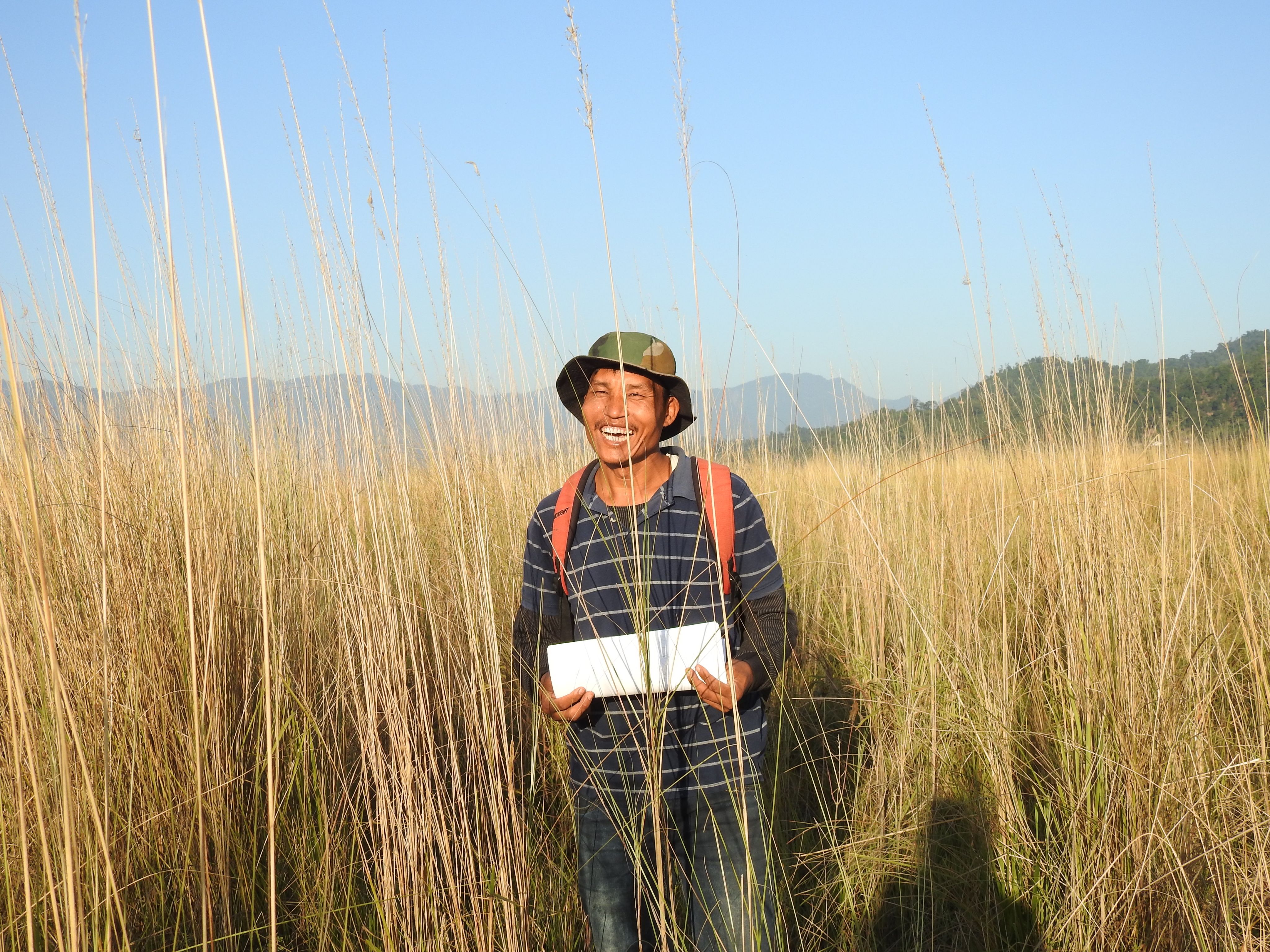
Can you tell what is unusual in this photograph?
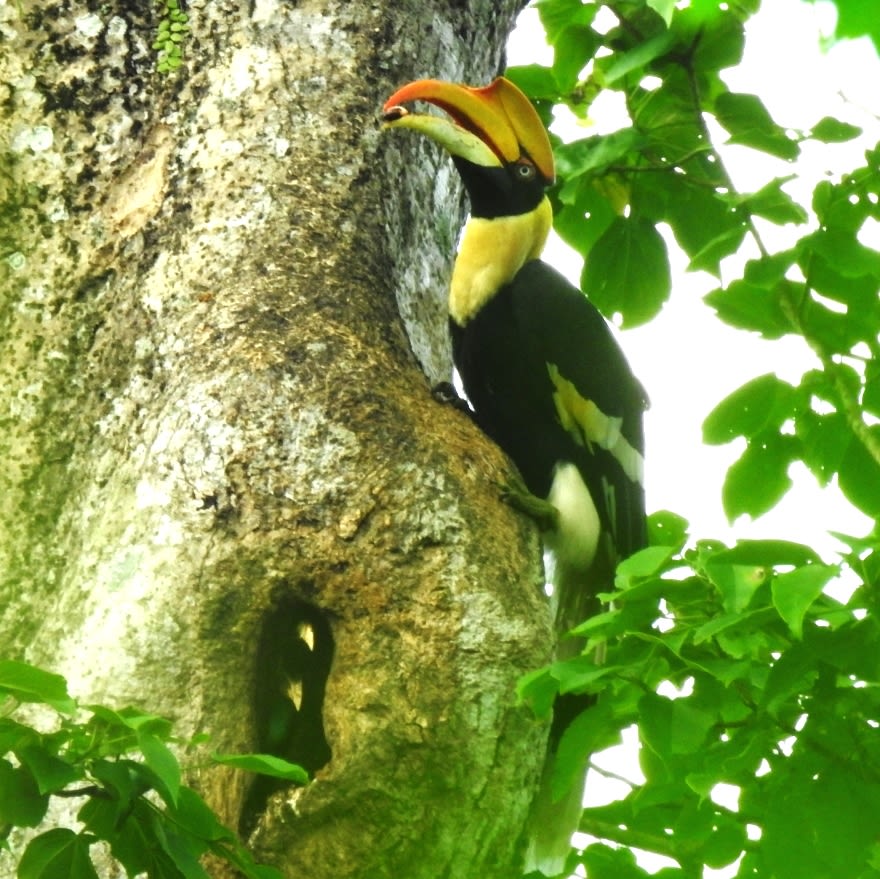
A female Great hornbill disturbs a breeding Wreathed hornbill
A female Great hornbill is perched with a food item in its beak outside the cavity that was occupied by a Wreathed hornbill pair. The blue throat pouch of the Wreathed hornbill is visible in this photograph if you look closely.
Taring Tachang, the nest protector who was monitoring this nest shared that determining the occupants of this nest was very puzzling for him. In his observations, he had recorded that the nest was first occupied by a Great hornbill pair on 28th March, but was abandoned subsequently on 31st March.
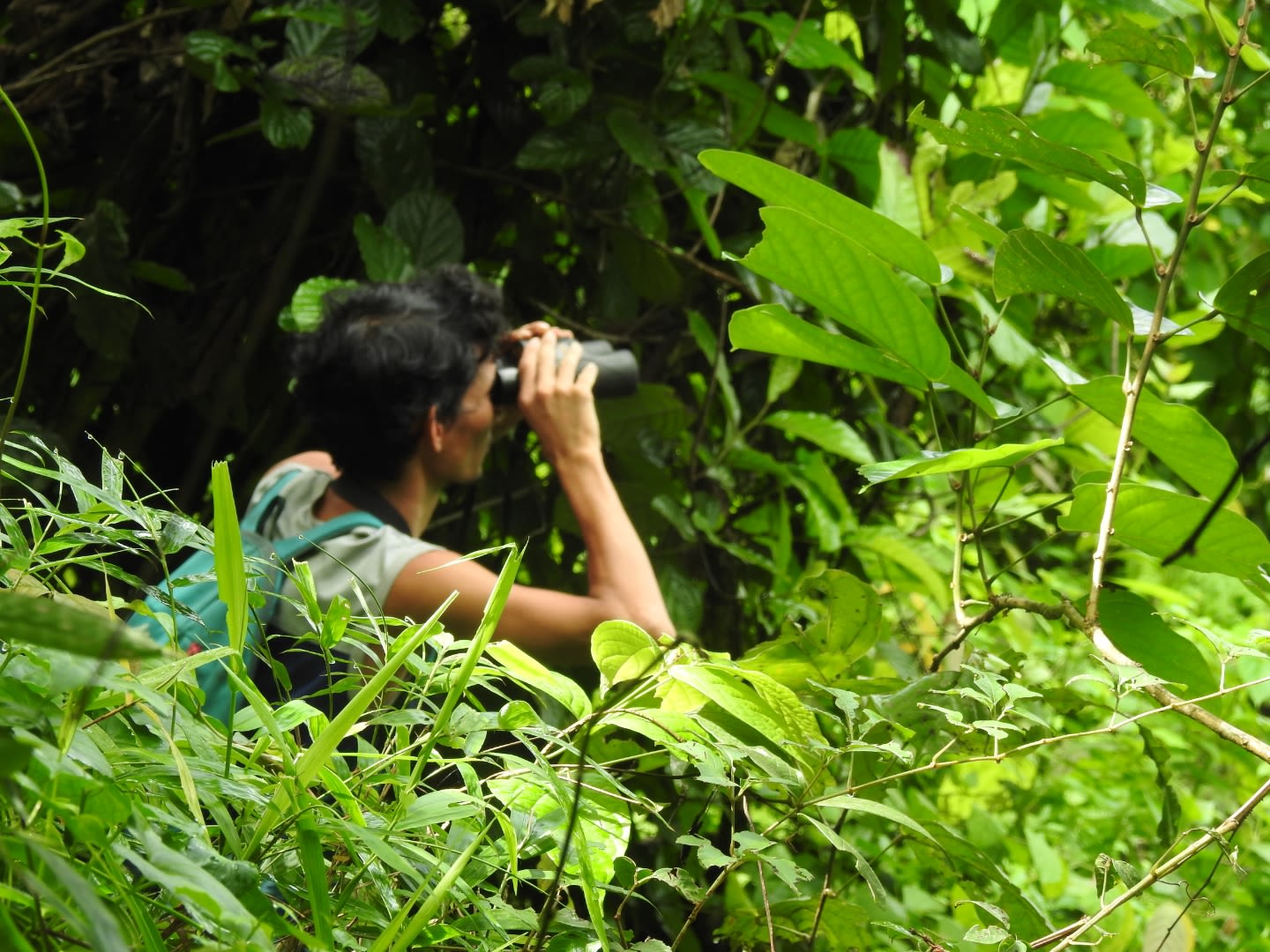
Taring carefully monitoring the nest
Taring carefully monitoring the nest
He continued visiting the nest, and found the nest again active on 11th April 2021, but to his utter confusion, both Great and Wreathed hornbills were visiting the cavity. Because of the sealing, he was unable to determine the hornbill inside the cavity.
Tajik, the local co-ordinator started accompanying Taring on his nest monitoring visits and finally on 22nd April confirmed that the nest was being used by Wreathed hornbills.
They also then observed that the Great hornbill that was visiting the nest was a female.
The Great hornbill female was seen visiting the nest and disturbing the breeding Wreathed hornbill female who was sealed in the cavity throughout the breeding season.
A short clip of the interaction between the female Great hornbill and the breeding female Wreathed hornbill is shared below.

A female Great hornbill disturbs a breeding Wreathed hornbill
A female Great hornbill disturbs a breeding Wreathed hornbill
Your support is crucial to continue this program
Please continue to support and adopt hornbill nests and help us sustain the Hornbill Nest Adoption Program (HNAP).
Donation are eligible for Income tax exemption under 80 G (for salaried employees) or under Sec 35 (for professionals).
Indian citizens: please donate by clicking on the link below.
Or you can send us a cheque in the name of 'Nature Conservation Foundation'
Address: Smita Prabhakar, 1311 12th Main Vijayanagar 1st Stage, Opposite Kodava Samaj, Mysore - 570 017
Or make an online bank transfer.
The bank account details to transfer funds are:
For salaried employees - Section - 80 G (Exemption 50%)
Name : Nature Conservation Foundation A/C No : 912010039076365 A/C type : Savings IFSC code : UTIB0000151 Bank Name : Axis Bank Ltd Branch : VV Mohalla, Mysore
For Professionals - Section - 35 (Exemption 150%)
Account Name : Nature Conservation Foundation A/C No : 912010067967491 RTGS/NEFT/IFSC code : UTIB0000151 Bank Name : Axis Bank Ltd Branch : VV Mohalla, Mysore
We cannot accept cash donations or cash deposits. If you do transfer the funds, please send an e-mail to karishma@ncf-india.org with PAN number, name and address of the person to whom the receipt has to be issued for IT exemption.
Foreign nationals can write to karishma@ncf-india.org or smita@ncf-india.org for details to donate under the FCRA.
You can also buy photo prints of Arati Kumar-Rao, a long-term supporter of HNAP, who has started a photo-sale in support of the HNAP.
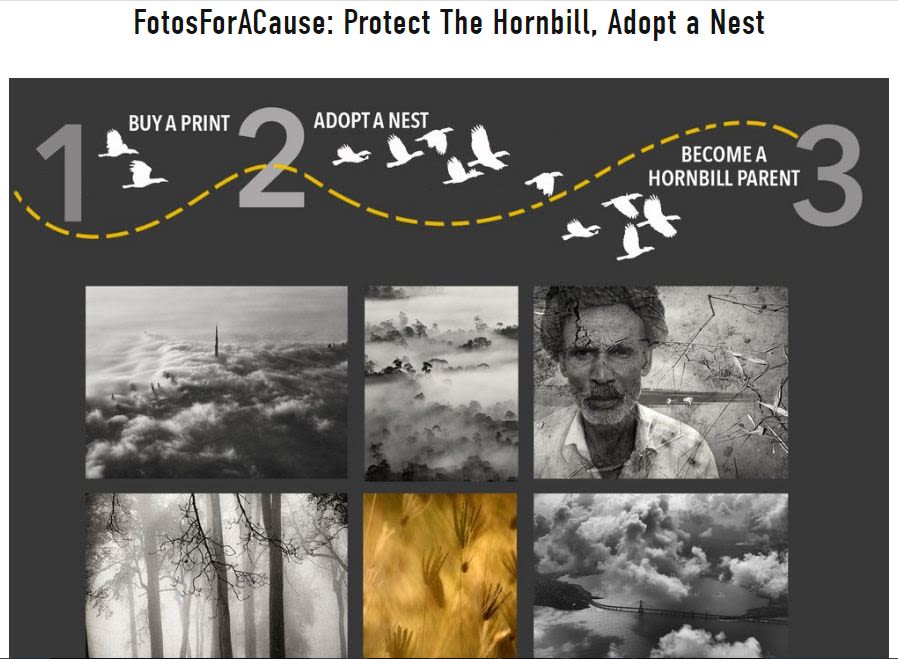
Nest monitoring in Pakke and Nameri Tiger Reserves
NCF has been conducting one of the longest hornbill nest monitoring programs in India for over 21 years in Pakke Tiger Reserve. Additionally, nests are also monitored in Nameri Tiger Reserve in Assam, which is contiguous to Pakke.
Nest monitoring inside Pakke Tiger Reserve started a bit late this year from mid-April, after our research permit was renewed. In Nameri TR, we had to stall our nest monitoring activities from May owing to restrictions by the Forest Department amidst the rising Covid cases.
In Nameri, there were 8 nests active this season, two of which were new nests located by the team this year. We could not determine the nesting duration or success for the nests in Nameri this year.
In Pakke Tiger Reserve, while we could not record the female entry dates this year, the team recorded 22 active nests when the team started monitoring from April. Two new Wreathed hornbill nests were also located by the team in Pakke TR this year.
Nesting summary of hornbill nests inside Pakke and Nameri Tiger Reserves, Arunachal Pradesh, 2021
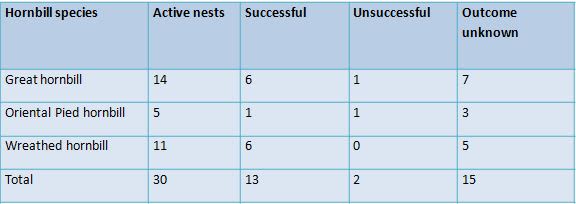
The nesting success in Pakke Tiger Reserve was 93%.
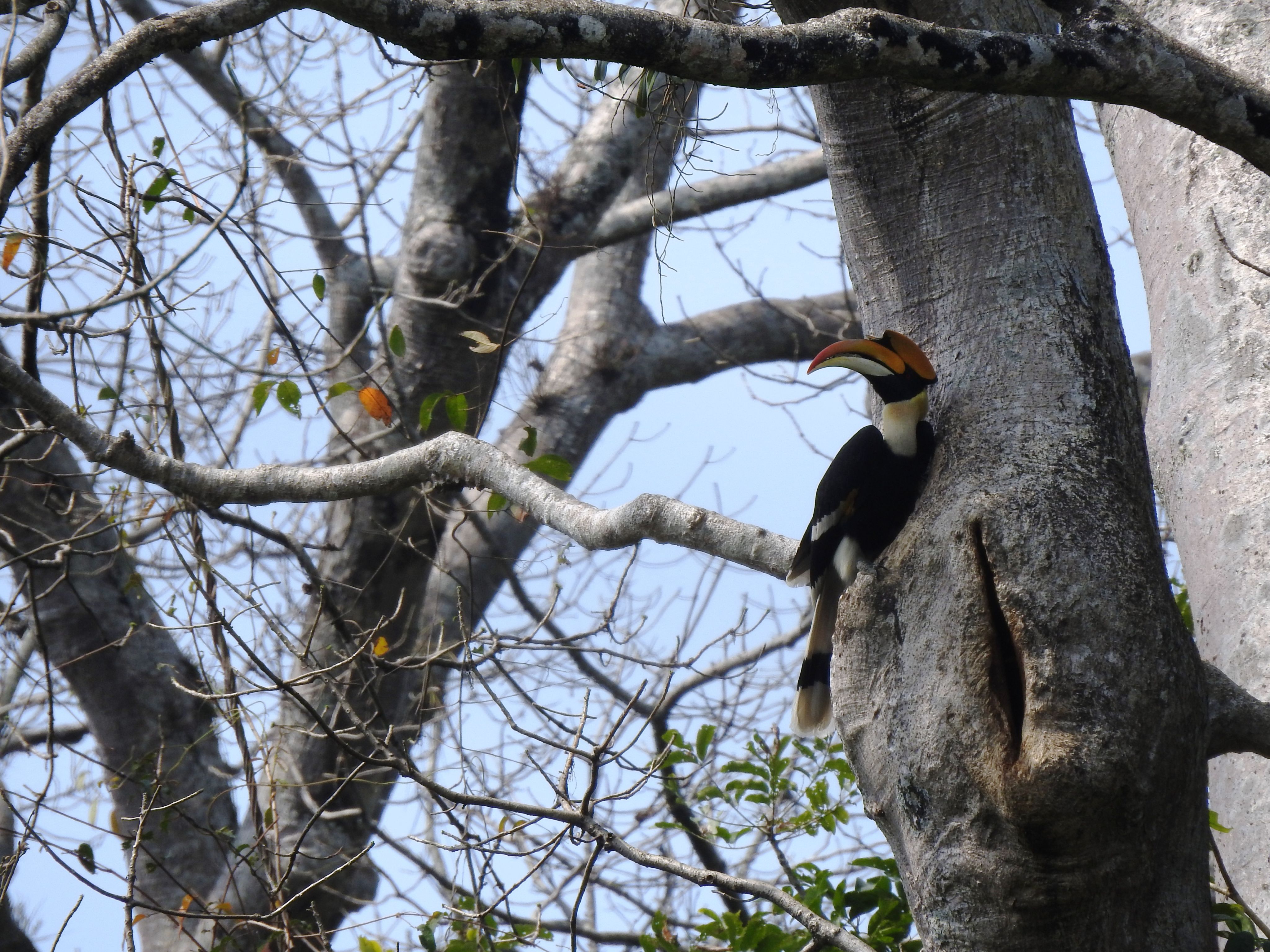
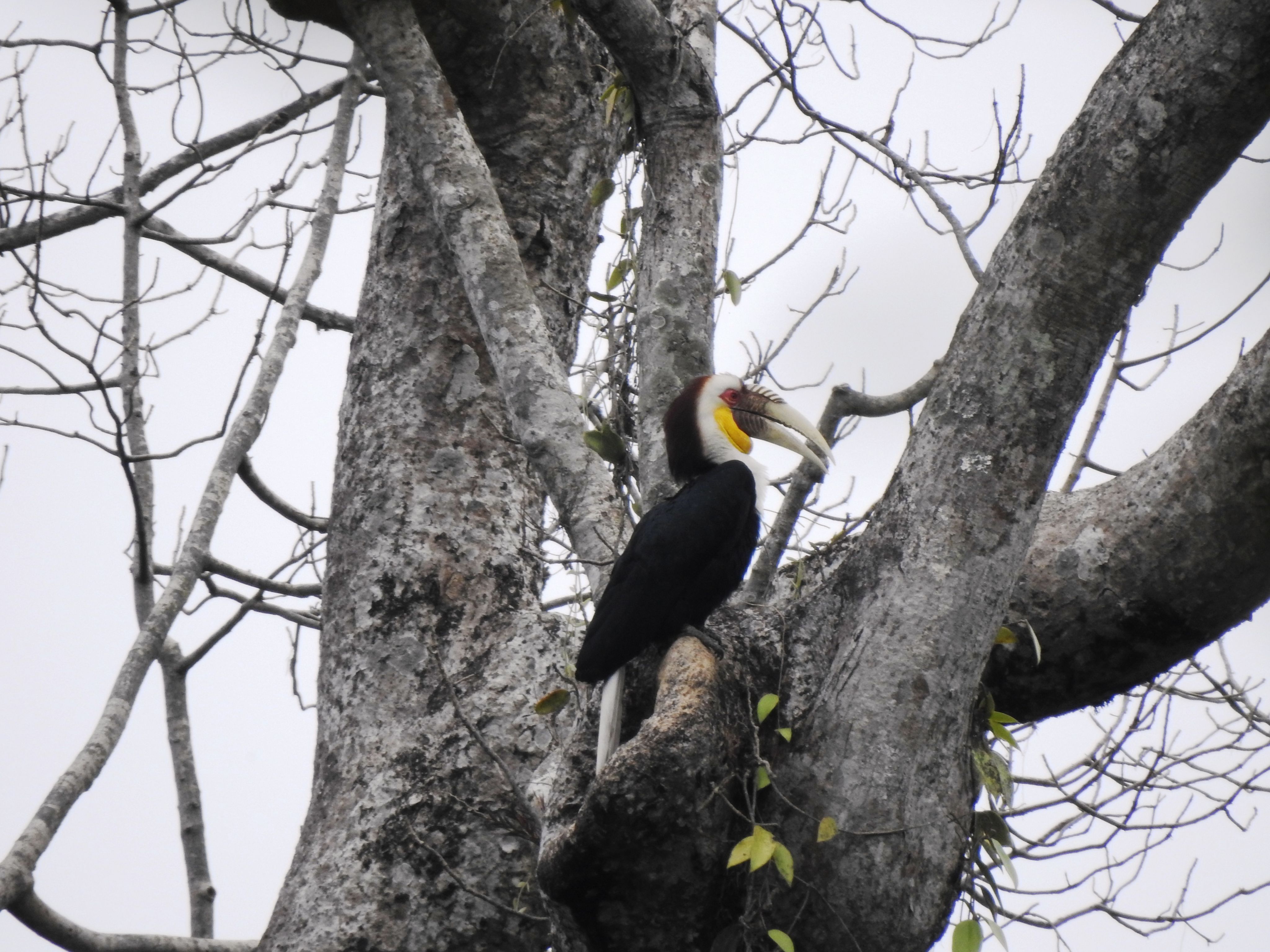
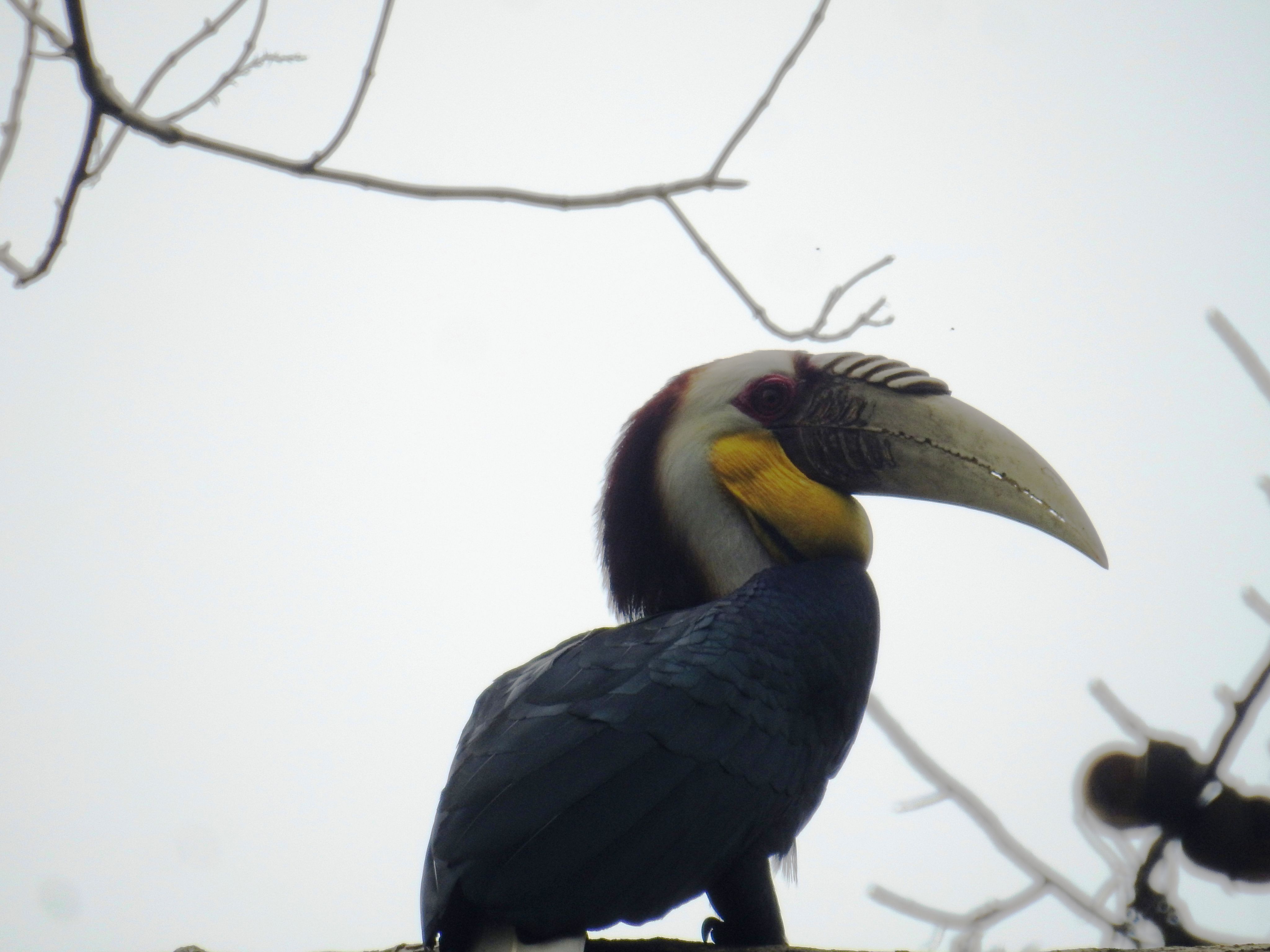
Other work updates in the Eastern Himalaya
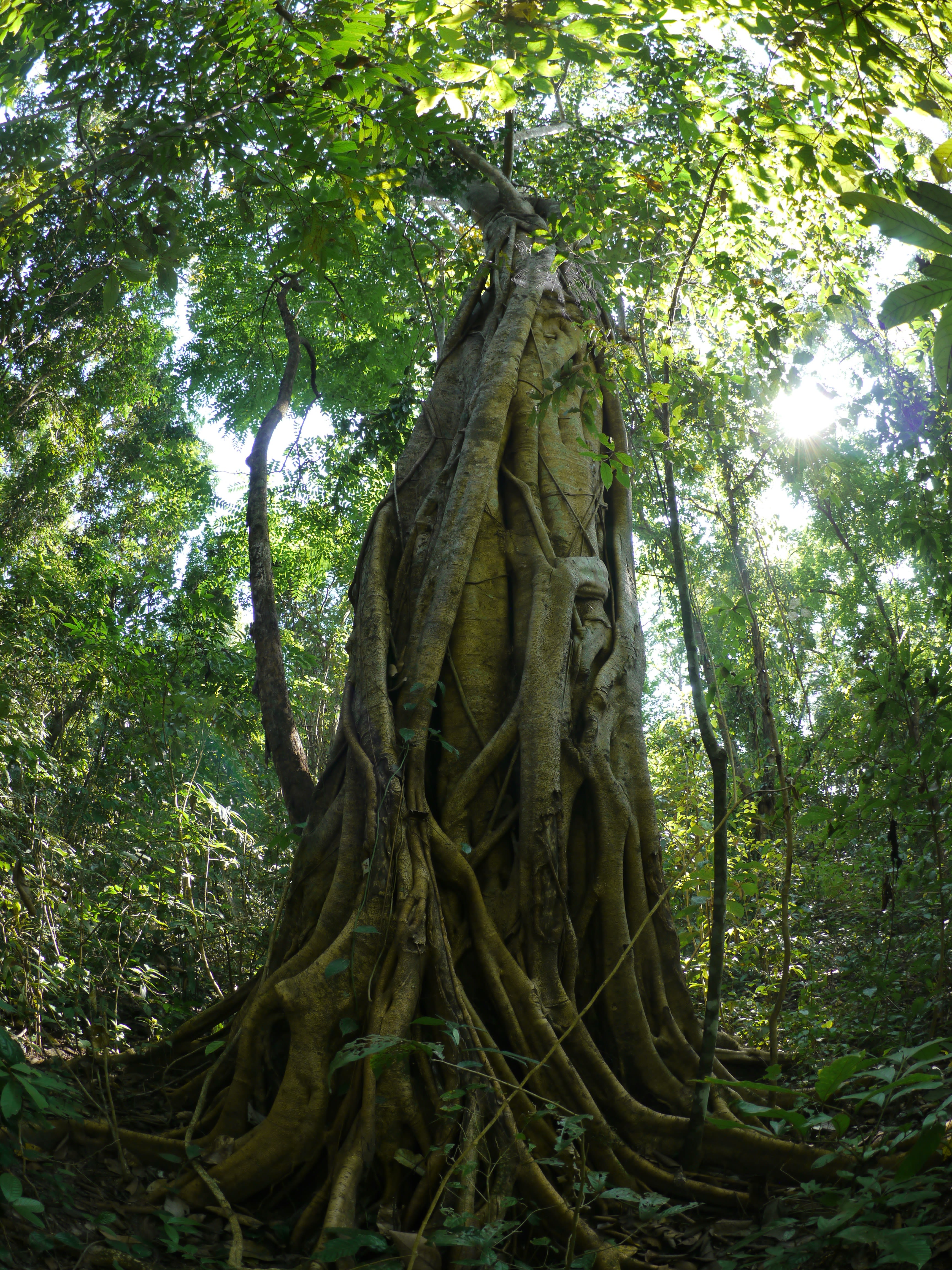
Tropical forest restoration
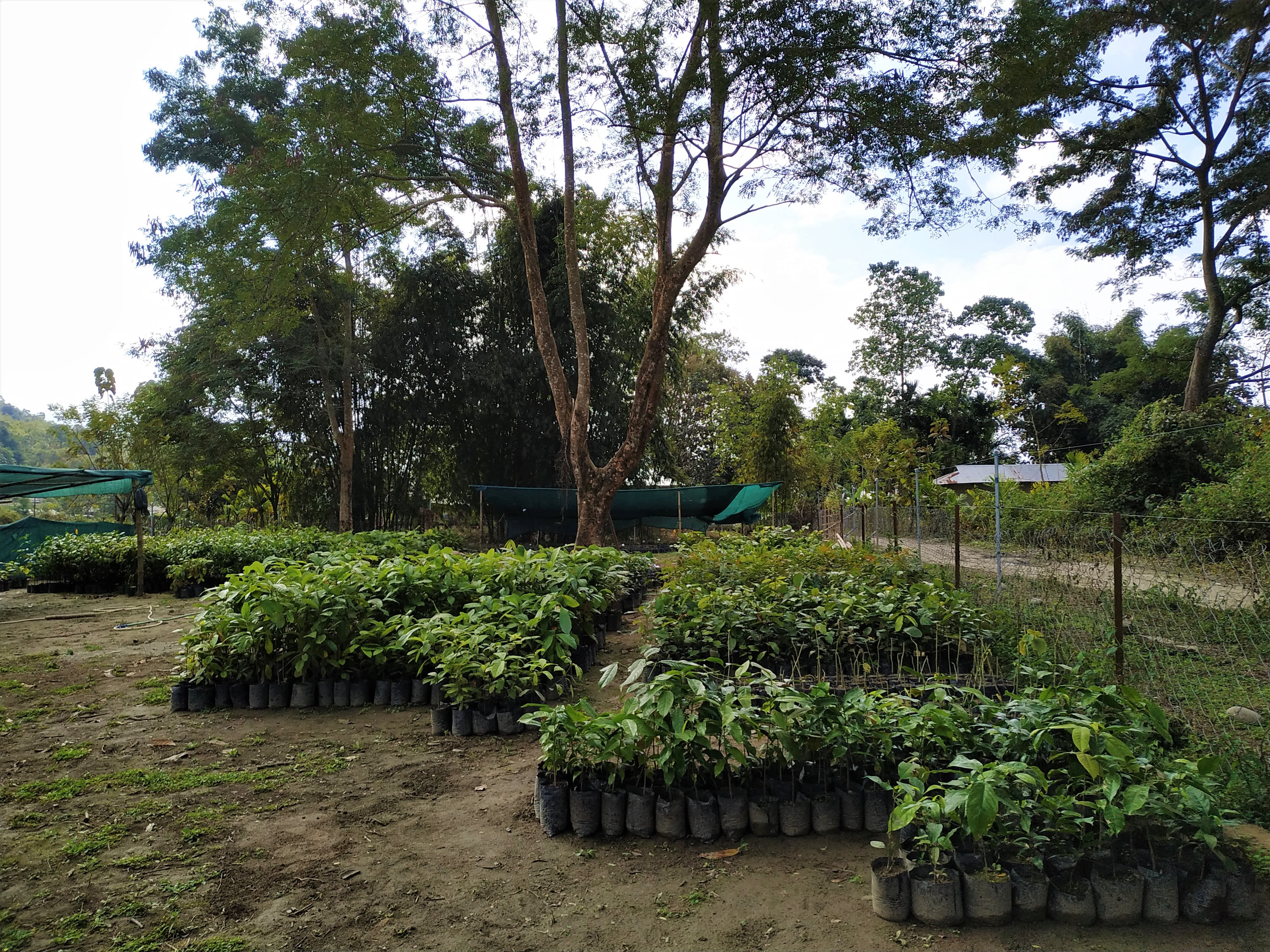
Native tree species saplings at NCF’s nursery in Seijosa, Arunachal Pradesh
Native tree species saplings at NCF’s nursery in Seijosa, Arunachal Pradesh
The restoration project was initiated in 2014, to restore some of the degraded patches in the Pakke Tiger Reserve landscape and surrounding areas of Assam, which are an important habitat for a variety of wildlife species. We have been carrying out forest restoration in this landscape since 2014. We have grown around 37,000 saplings of 75 native tree species at our nursery and planted in an area of ~13 ha so far.
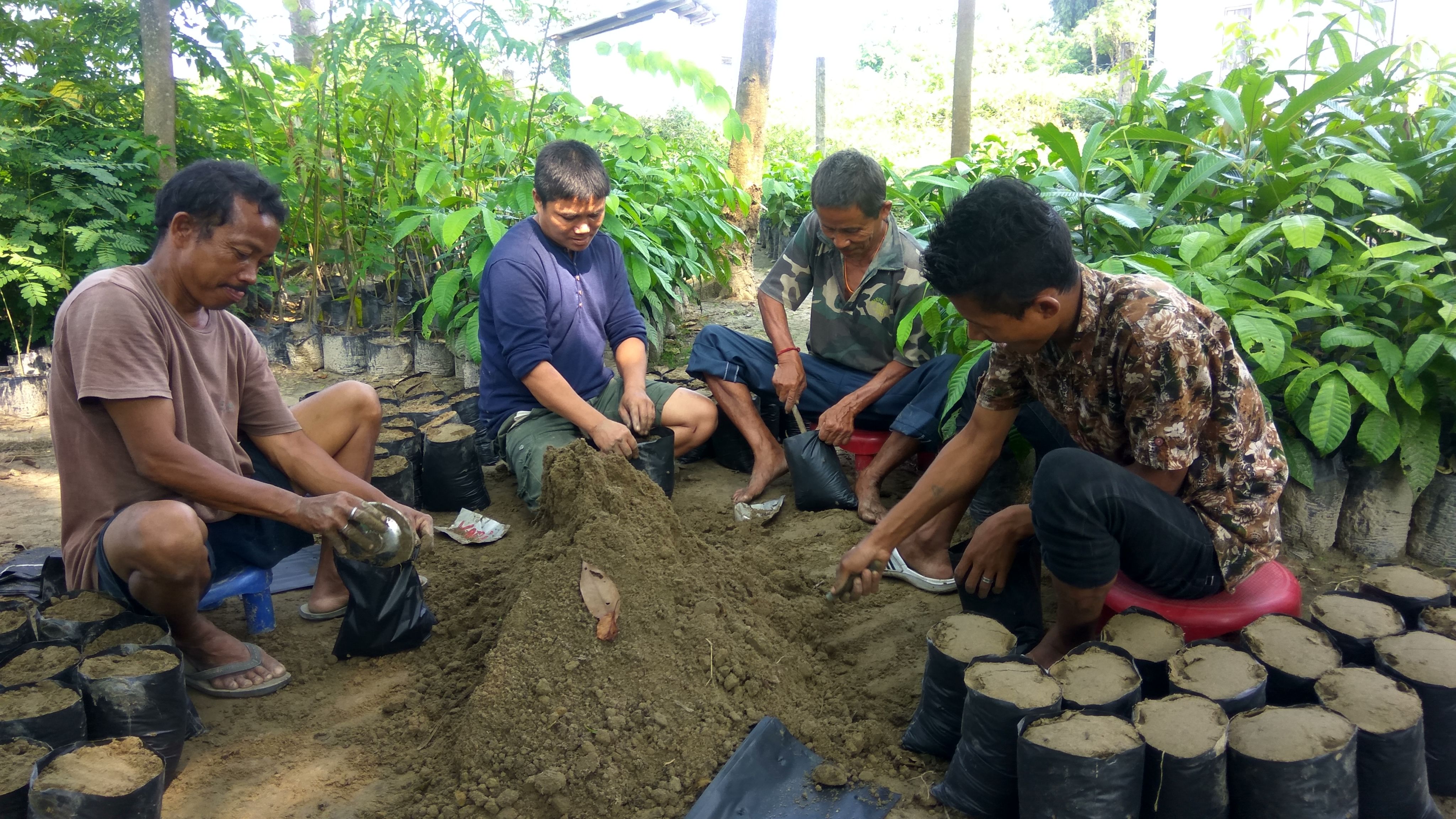
Field staff filling up pots for growing seedlings at NCF’s rainforest nursery
Field staff filling up pots for growing seedlings at NCF’s rainforest nursery
The year-round nursery activities to raise good quality planting stock are carried out by our trained local staff.
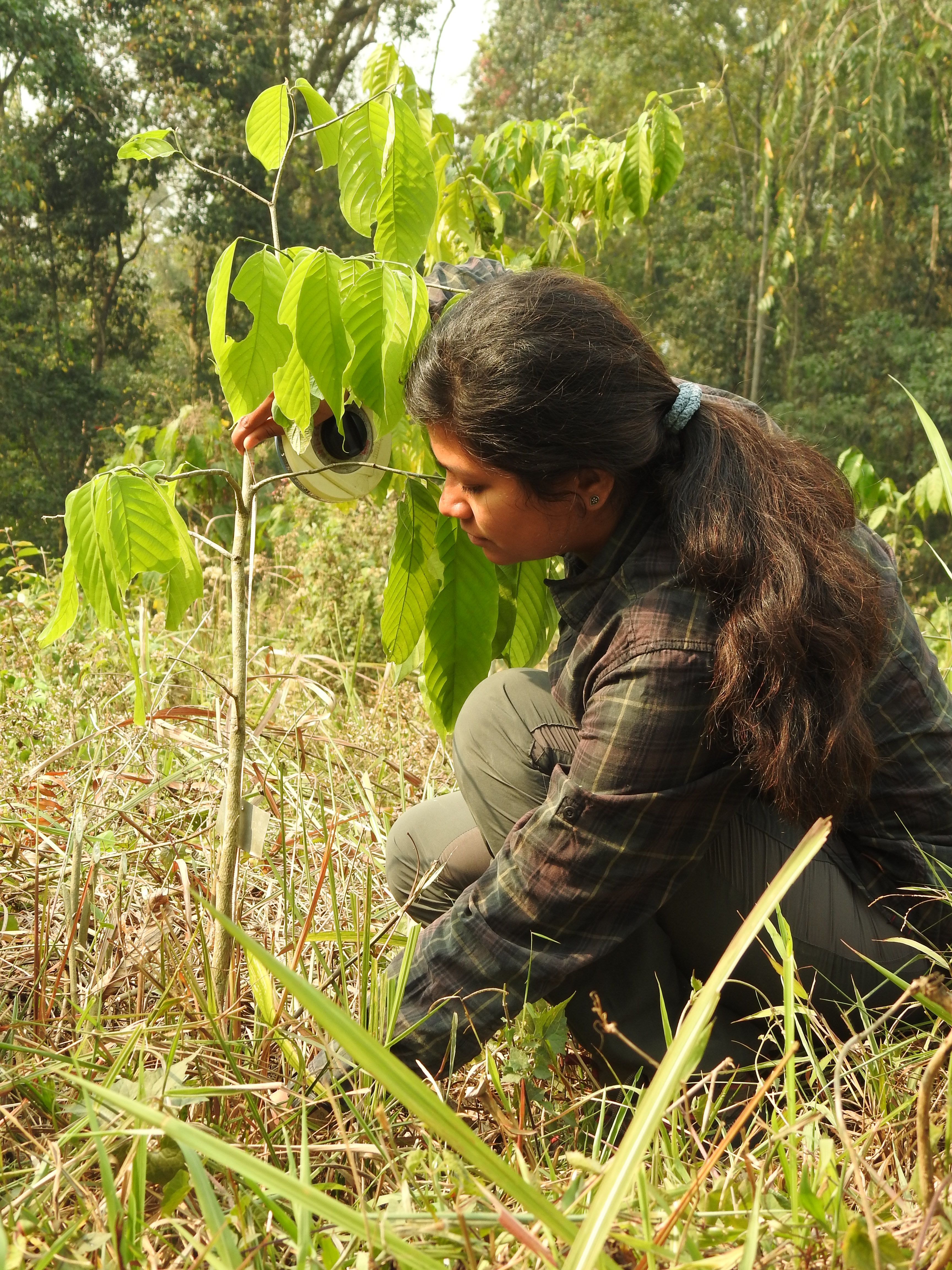
Noopur monitoring height growth of a planted sapling
Noopur monitoring height growth of a planted sapling
We carry out maintenance activities like weeding around the planted saplings to maximize survival and monitor them to improve our future restoration efforts. Survival varies from 31 to 69% at different sites after 2-3 years of planting.
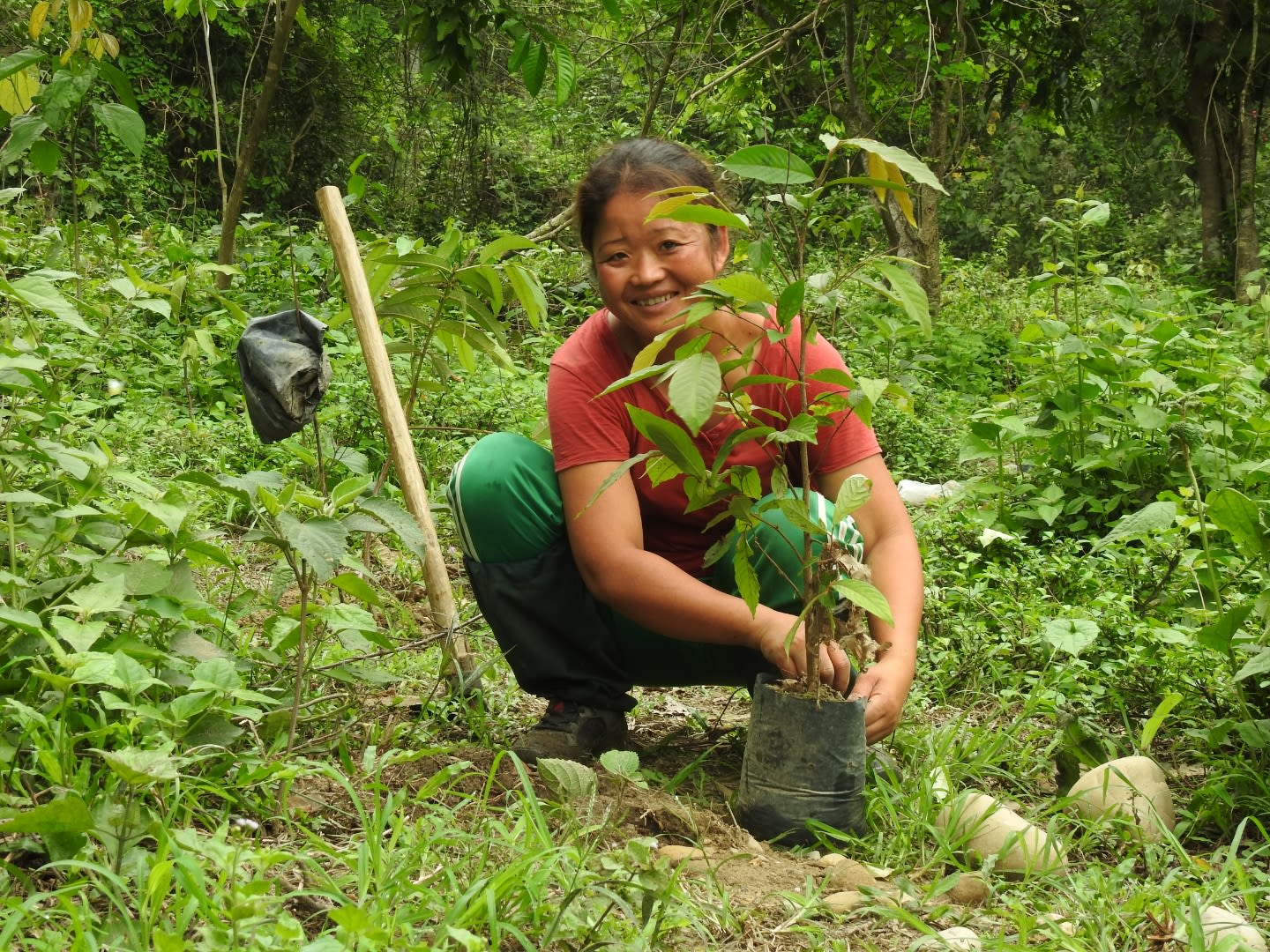
Sital Dako, our field staff planting a sapling at a restoration site from 2021
Sital Dako, our field staff planting a sapling at a restoration site from 2021
In 2021, we raised 7905 seedlings and saplings at our nursery. In March, we surveyed some degraded sites for restoration. After selecting sites, the weeds were cleared and we dug pits at the end of April. After the onset of monsoon, we carried out planting from 21st to 25th May.
We planted 3368 saplings of 74 species at 3 different sites inside Pakke Tiger Reserve and covered an area of 1.2 ha, with the help of our local staff, labourers and volunteers. We monitored the survival and growth of the planted saplings towards the end of June.
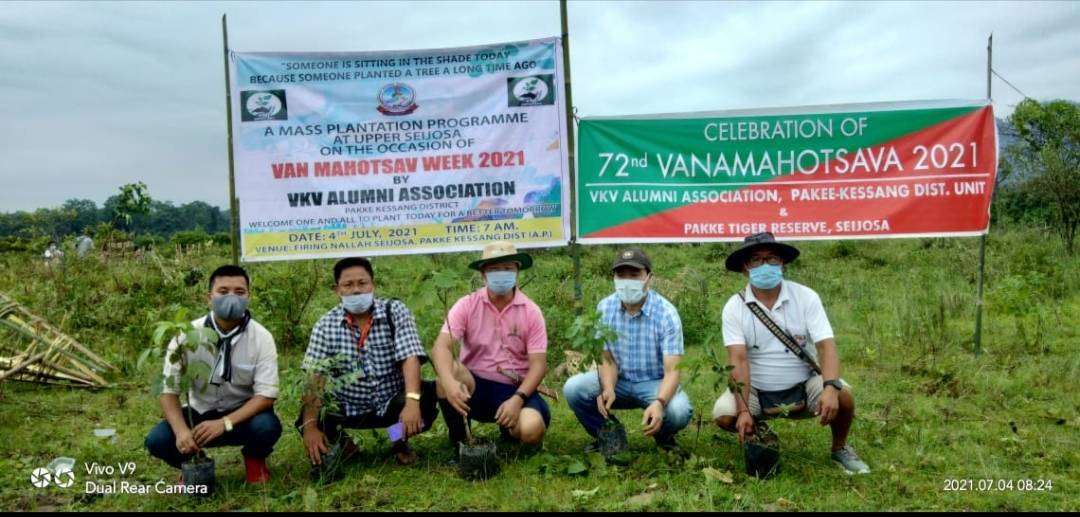
Plantation drive by local groups and forest department on the occasion of Vana mahotsava Week, Arunachal Pradesh
Plantation drive by local groups and forest department on the occasion of Vana mahotsava Week, Arunachal Pradesh
A total of 700 saplings were provided to a tea estate in Assam, to plant in some fallow areas. The planting was done by them in June and the saplings were fenced to safeguard them from livestock grazing.
We also provided 996 saplings to the local villagers for planting on their farm lands/ home gardens and government organizations for various planting events.
Workshop on tropical forest restoration
NCF in collaboration with Green Hub, conducted a three-day workshop on ‘Tropical forest restoration in Eastern Himalaya – Concepts and Practice’ in Tezpur, Assam, for 21 participants from the north-eastern region.
During the workshop, participants were introduced to designing a systematic approach for science-based forest restoration, with clear emphasis on selecting appropriate species.
The sessions covered basic concepts of restoration with key learnings from NCF’s 20+ years of restoration efforts in the Western Ghats and 7 years of restoration work in the Pakke landscape of Arunachal Pradesh.
Site-specific case studies were also discussed, followed by a field visit to Pakke Tiger Reserve and NCF's nursery at Seijosa.
Nature Education Program
Through our Nature Education Program with local schools, we conduct year-round nature activities and annual Nature Camps inside Pakke Tiger Reserve, every year.
Due to the pandemic we could not conduct the annual camps in November 2020. But to continue our engagement with the students, we carried out the following activities.
Online activities
Twenty-three students from Class 5-9 participated in playing different bingo games online from November 2020 to December 2020, from one of the registered schools. These games are designed to encourage students to go out and observe nature in their own backyards/locality and connect with it in the process.
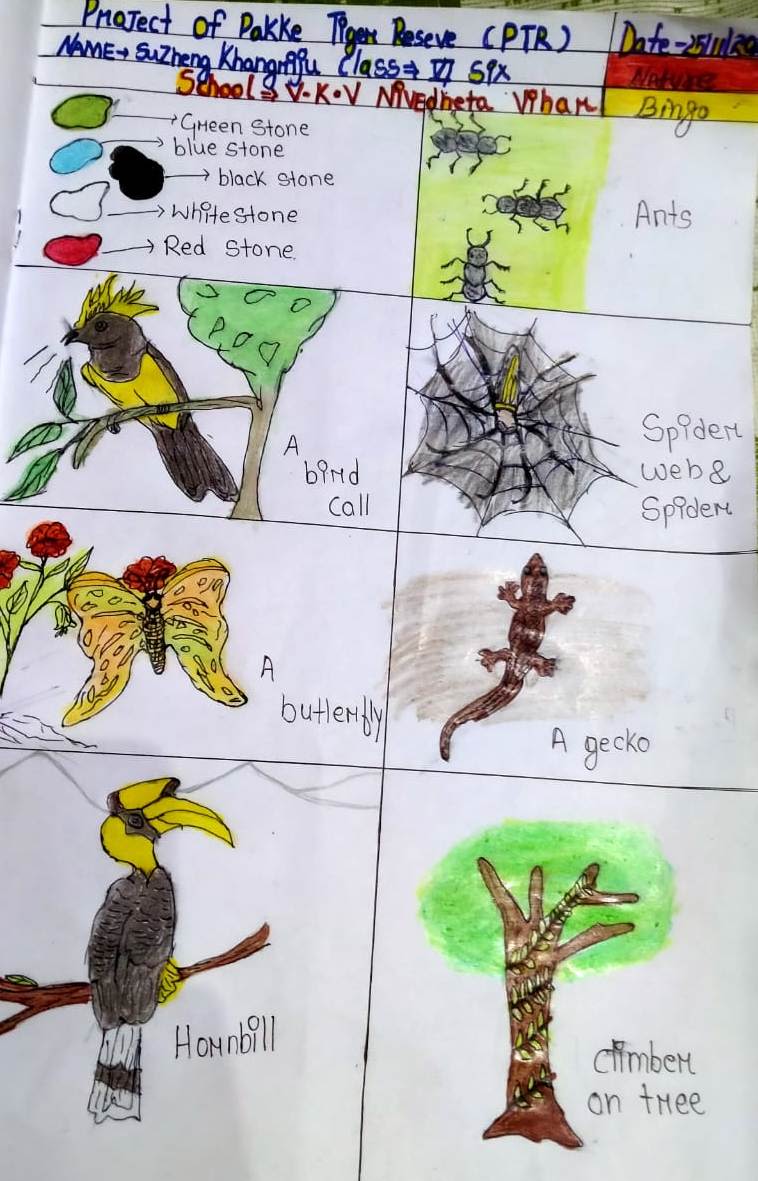
Nature bingo sheet during online nature games session
Nature bingo sheet during online nature games session
Visit to NCF's rainforest nursery
A group of 10 students from Class 6 and Class 7 from Darlong Govt. Secondary School visited our Rainforest Nursery in January 2021 to learn about the importance of the rainforest nursery, basics of seed dispersal and forest restoration.
Bird walks
We organized two bird walks with students from two schools in January 2021; one of them inside Pakke Tiger Reserve and the other inside the school campus. Twenty students participated in the event. Through these bird walks, we plan to create a Pakke Birding Club in future with students specifically interested in the activity.
Resource material
We developed a colouring book and nature journal on wildlife of Pakke to be distributed during the camps to encourage students to connect to nature through art. We have also reproduced copies of Birds of Pakke brochure that had been initially developed for the Arunachal Pradesh Forest Department during the Pakke Paga Hornbill Festival 2019. This brochure contains 138 familiar birds of Pakke region.
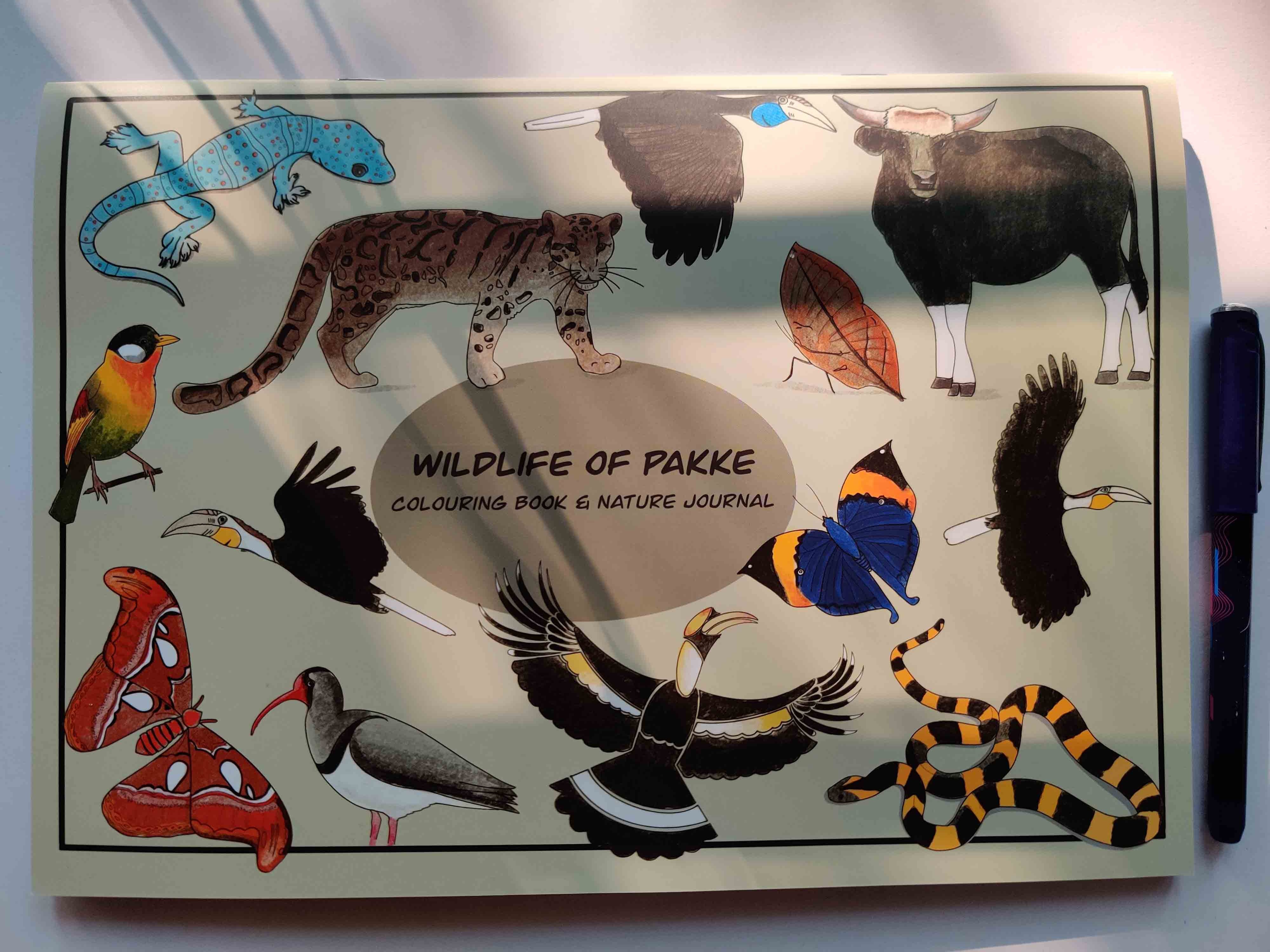
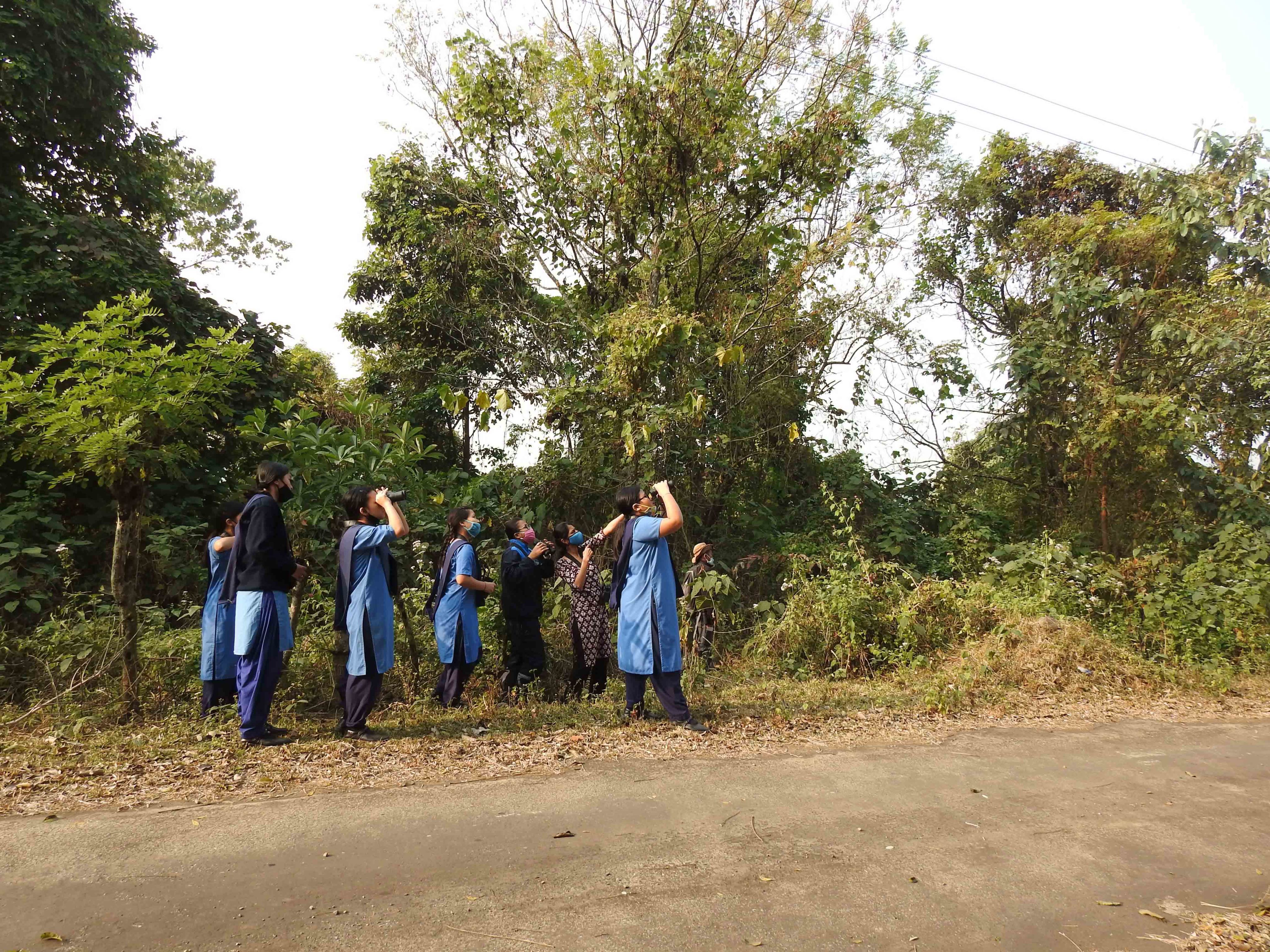
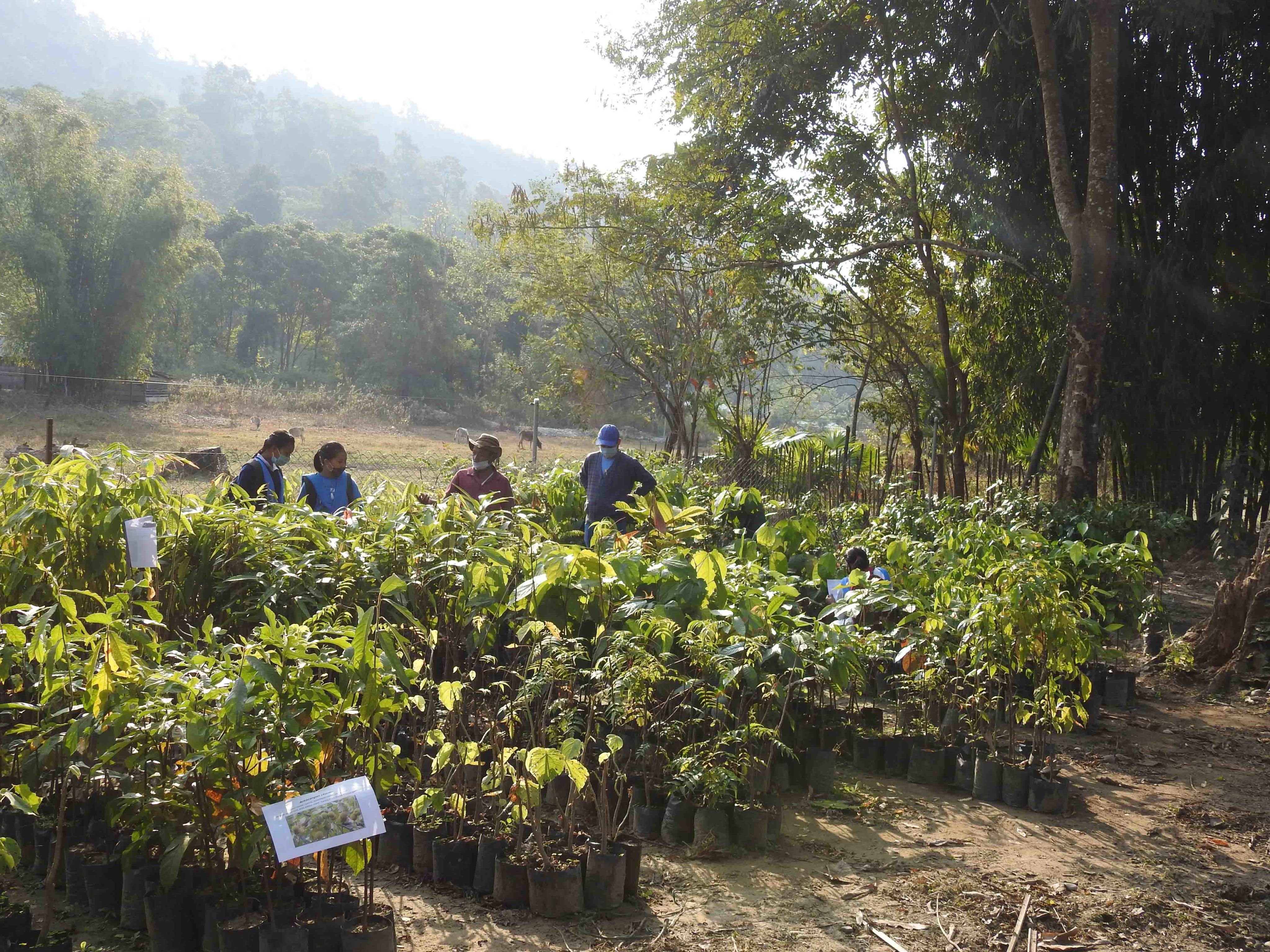
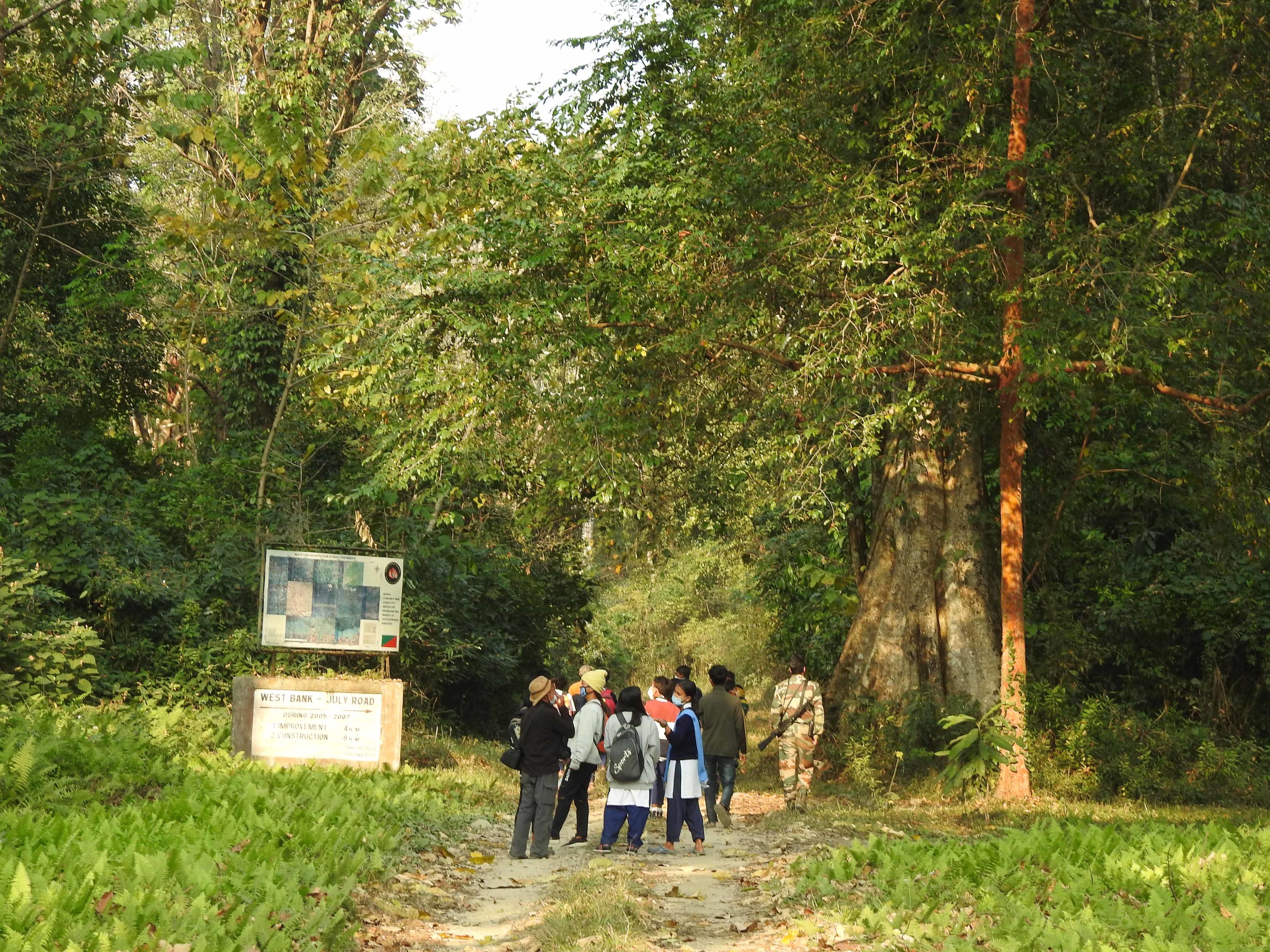
Hornbill conservation
in other sites
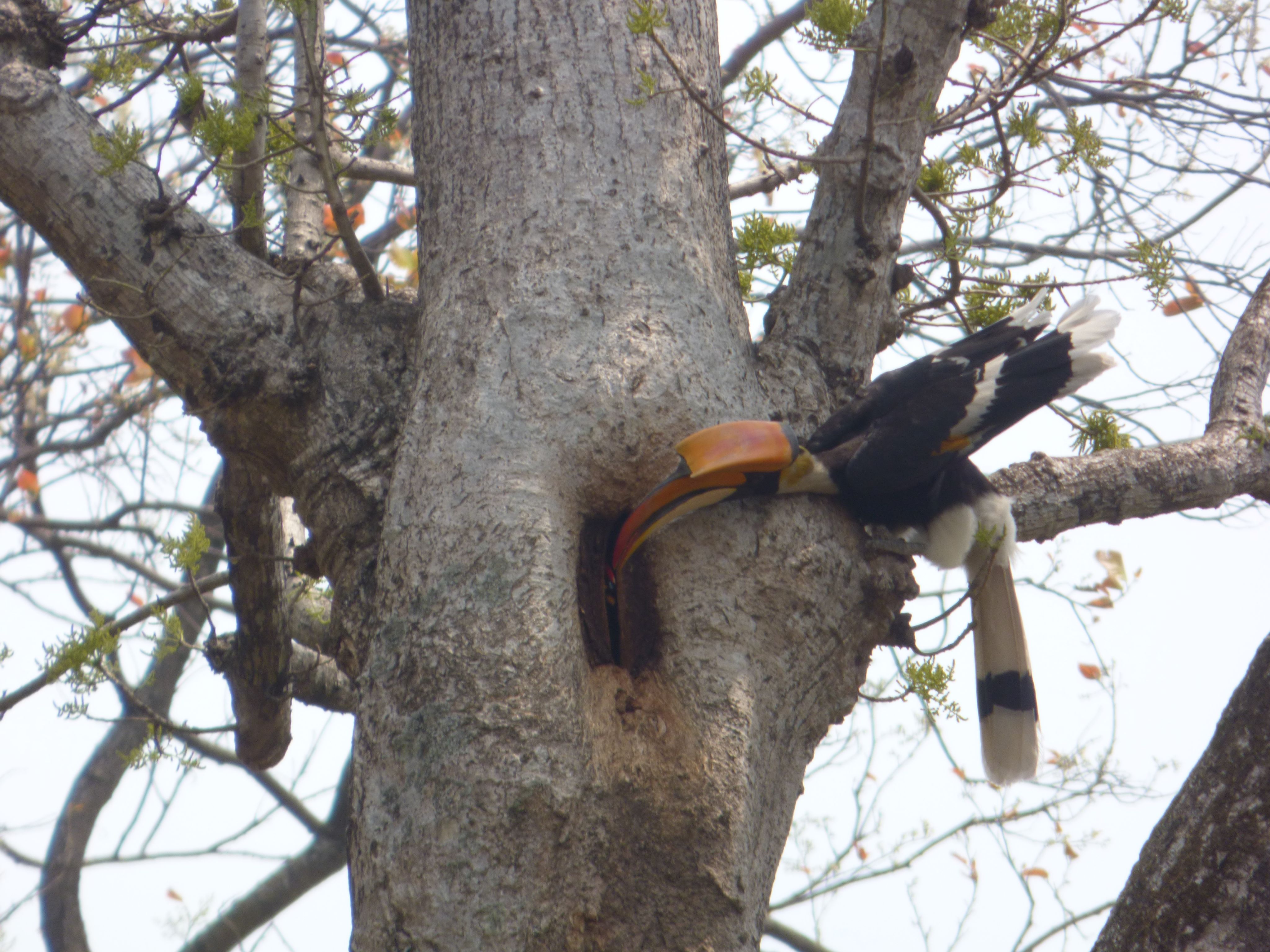
Buxa Tiger Reserve, West Bengal
Since 2017, NCF in collaboration with Nature Mates Nature Club has been studying hornbills in north Bengal, particularly in Buxa Tiger Reserve.
One of the major focus areas of this research was to collect baseline information on hornbill population from this region.
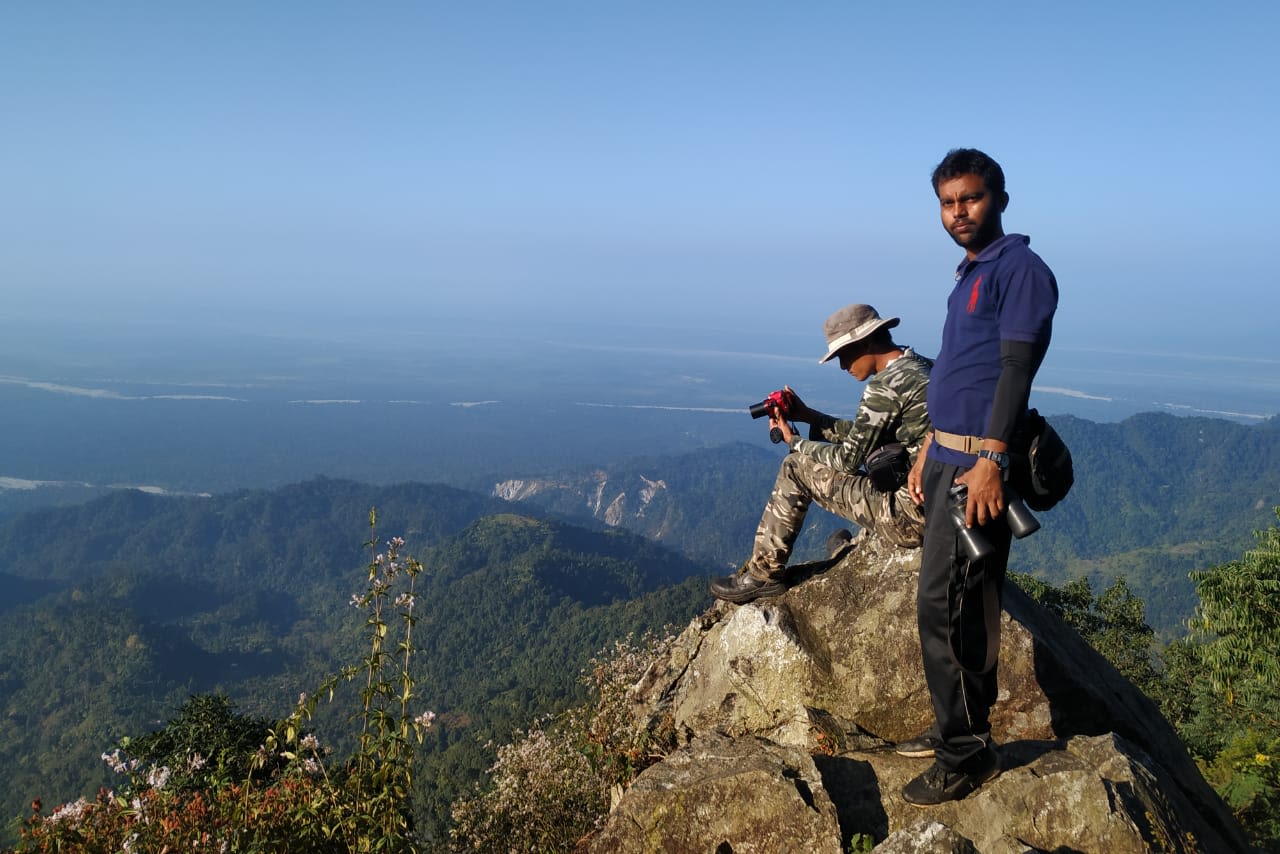
Sitaram and Kejang after a transect survey in Buxa Tiger Reserve
Sitaram and Kejang after a transect survey in Buxa Tiger Reserve
From November 2020 to March 2021, the team repeated transects conducted in the previous year across the entire area of Buxa Tiger Reserve.
With this effort, we collected information on hornbill detections for two non-breeding seasons. The total effort in this period was 119 km of transect walks across 80 trails in 27 grids.
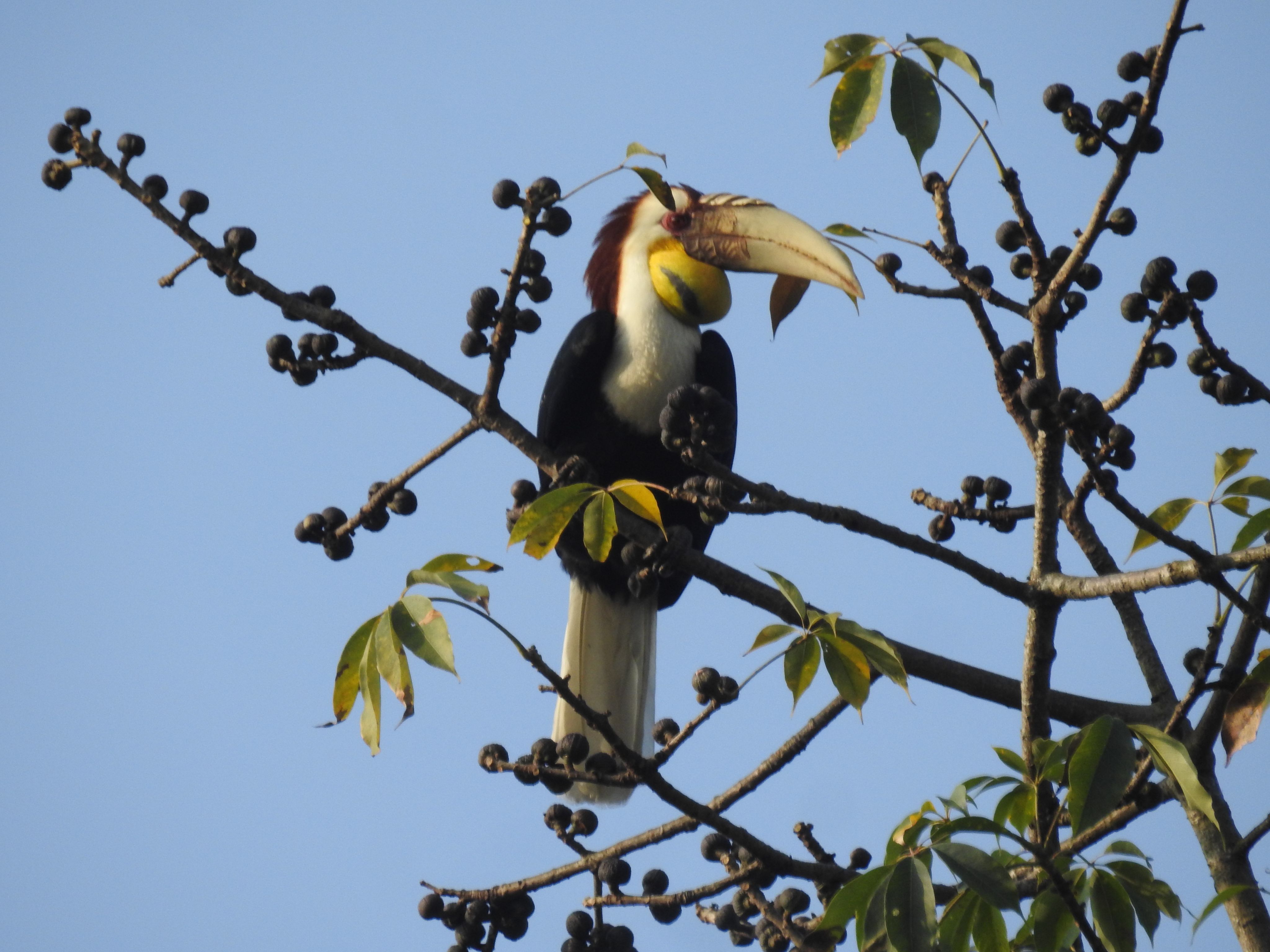
Wreathed hornbill seen during a transect in Buxa Tiger Reserve
Wreathed hornbill seen during a transect in Buxa Tiger Reserve
Densities of all four hornbill species were estimated from study that was conducted in the two non-breeding seasons in Buxa Tiger Reserve.
The densities are as follows:
Great hornbill: 0.21 birds/ km2 (0.06-0.79),
Wreathed hornbill: 0.49 birds/ km2 (0.17-1.45),
Rufous-necked hornbill: 0.04 birds/ km2 (0.01- 0.02),
Oriental Pied hornbill: 10.58 birds/ km2 (6.4 -17.48).
Vegetation study
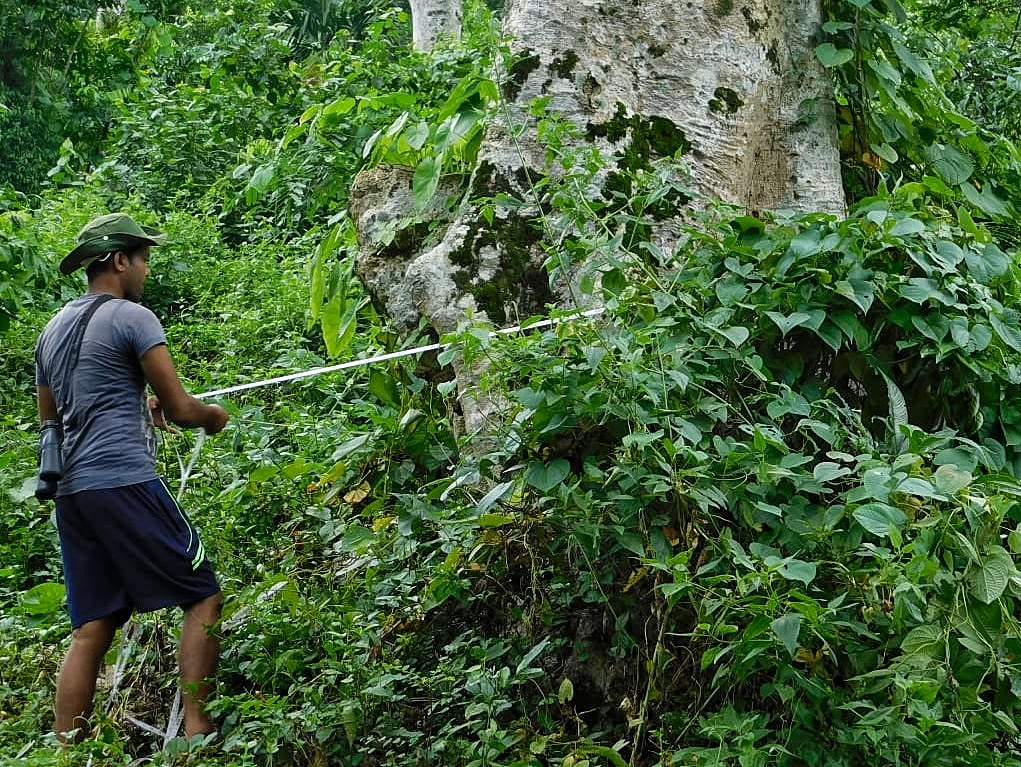
Studying the forest structure of Buxa Tiger Reserve
Studying the forest structure of Buxa Tiger Reserve
Along with hornbill densities, the team also collected vegetation data to understand the vegetation structure and composition in Buxa TR.
The tree density (GBH ≥ 25 cm) in Buxa ranged from 6 trees per ha to 425 trees per ha with an average density of 92 trees per ha (SE ± 7.49).
Tree phenology
The team also initiated a tree phenology study in Buxa Tiger Reserve from January this year. An optimum number of individuals of 62 tree species were identified and marked. The fruiting, flowering and leafing patterns of 700+ individuals are recorded between the 21st and 25th of every month.
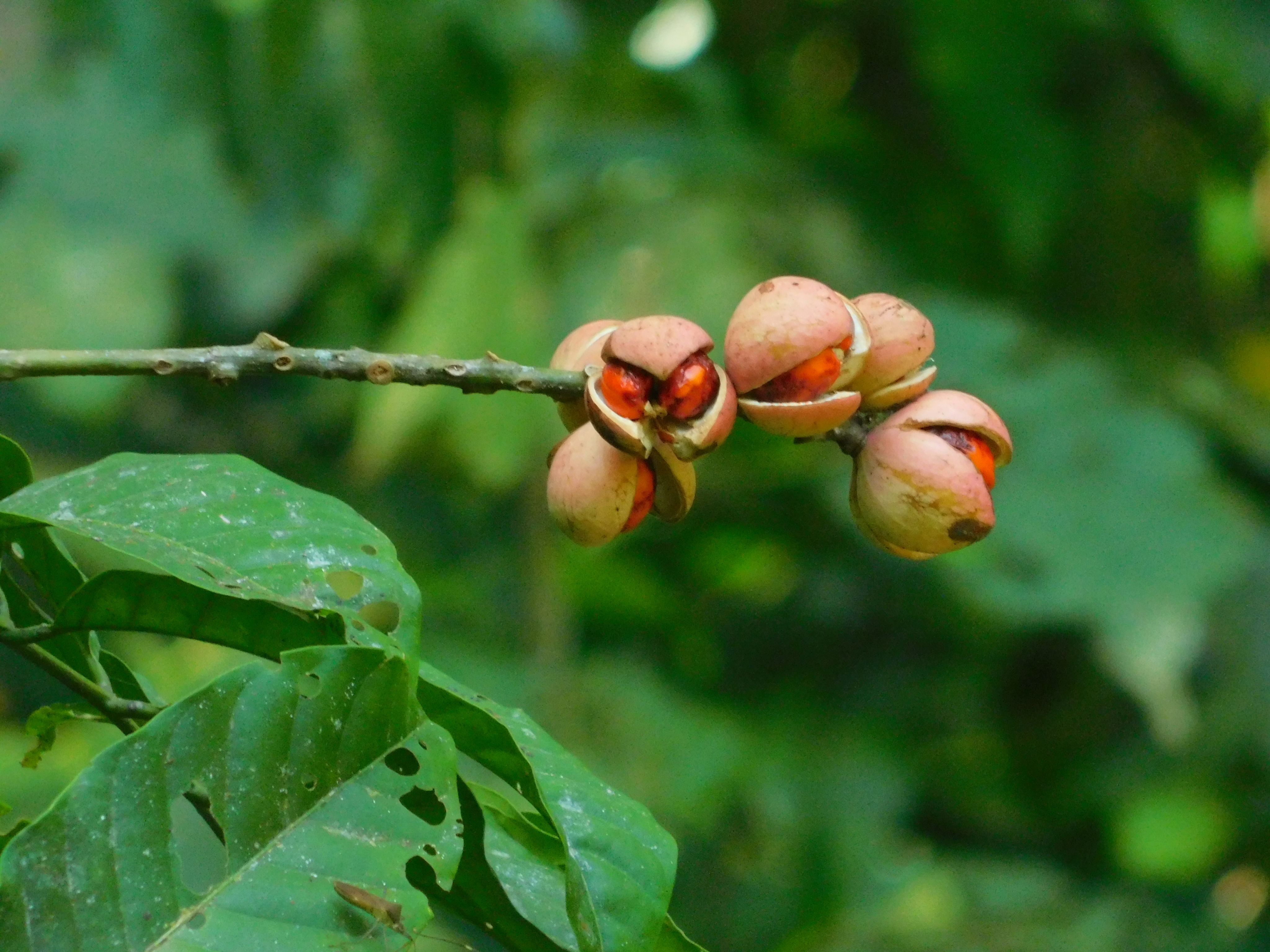
Ripe fruits of Aphanamixis polystachya
Ripe fruits of Aphanamixis polystachya
Hornbill nesting
The study of the hornbill breeding biology continued for the 4th consecutive year in Buxa Tiger Reserve.
The team monitored 25 known hornbill nests from February onwards. Out of these, 16 nests were occupied by breeding pairs - 6 Great hornbill, 1 Wreathed hornbill, 7 Oriental Pied hornbill and 2 Rufous-necked hornbill nests.
The overall nesting success this year was 90%.
For the first time, our team recorded two Rufous-necked hornill chicks that fledged from one of the nests.
Upper Assam
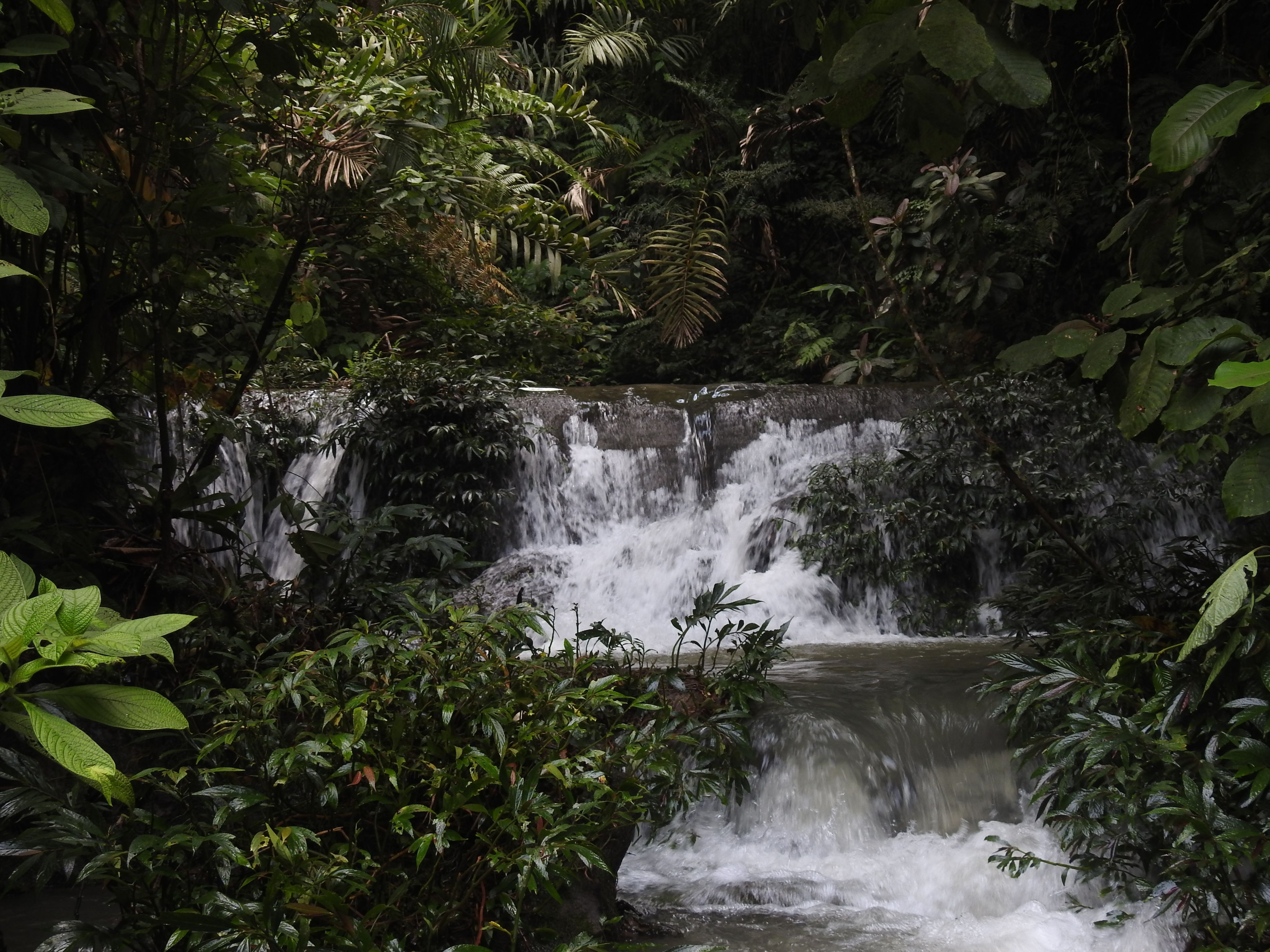
Last remaining forests of Lekhapani Reserve Forest
Last remaining forests of Lekhapani Reserve Forest
We assessed habitats in the fragmented forests in some of the reserved forests of Upper Assam landscape in 2021. From February to April 2021, we conducted vegetation sampling in Upper-Dihing West Block RF, Upper Dihing East Block RF, Burhi-Dihing RF and Torani RF. Our aim was to assess forest structure and habitat quality.
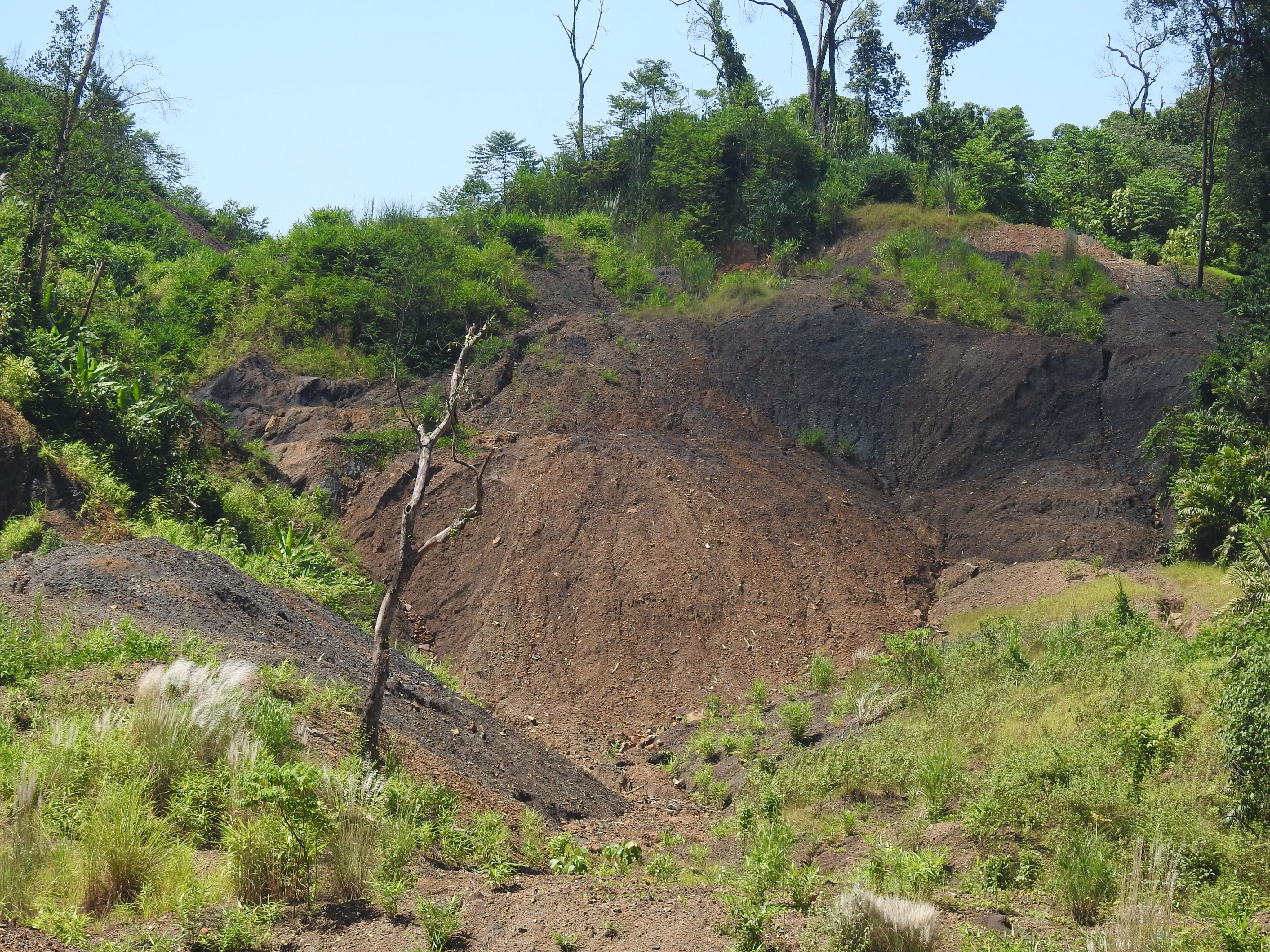
A portion of the habitat in Tinkopani Reserve Forest
A portion of the the habitat in Tinkopani Reserve Forest
In April 2021, Covid cases surged and we halted work in mid-April, until travel restrictions were lifted in August 2021. In September, we assessed the habitat of Makumpani RF, Tirap RF, Tinkopani RF and Lekhapani RF in 348 circular plots of 10 m radius along 38 transects.
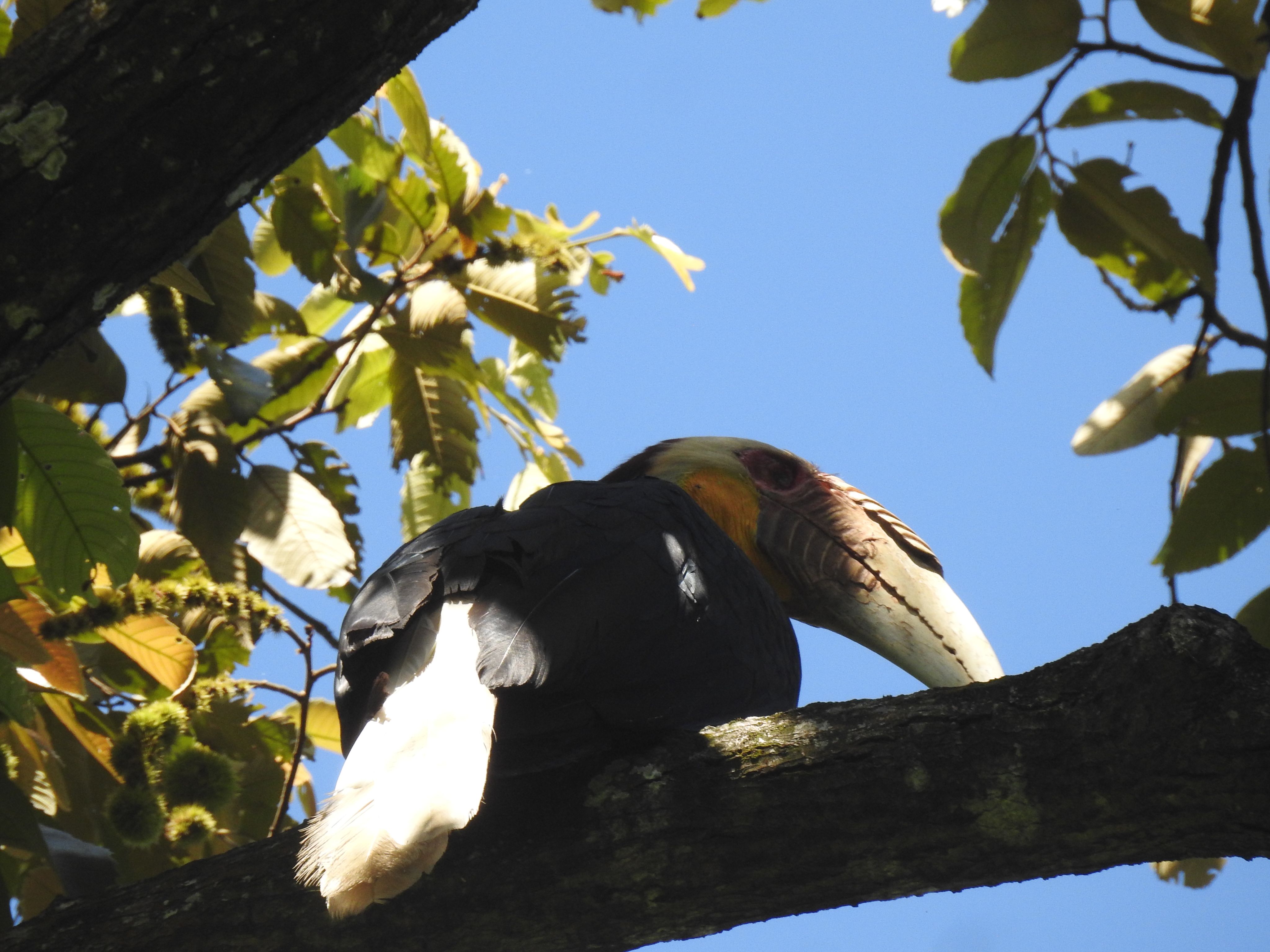
Wreathed hornbill sighted in Tinkopani Reserve Forest
Wreathed hornbill sighted in Tinkopani Reserve Forest
In a freshly logged site, we confirmed presence of 2 Brown Hornbills including a fledging from this year at Lekhapani RF. We encountered 10 Wreathed Hornbills in illegally coal-mined site of Tinkopani RF and 2 Great Hornbills in illegally logged forest of Tirap RF. The persistence of these endangered hornbill species in such fragmented and degraded forests calls for immediate action to protect these habitats from further loss and degradation.
Lack of conservation awareness and knowledge of the importance of such habitats is a concern. Stakeholder participation with strong protection measures will help any conservation initiatives in the last remaining rainforest habitats of Upper Assam. Restoration initiatives are warranted and would also benefit unemployed village youths and students, if they are engaged in such activities.
Covid-19 relief work
Covid’s second wave ravaged Indian cities and crippled the medical infrastructure even in metropolitan cities. During this period, many rural parts of North-east India were reporting high number of Covid cases, away from media attention.
To assist medical centres in handling ongoing Covid cases and to prepare for future surges, NCF started a Covid Relief Campaign to equip 54 local medical centers within reach of many remote villages, across Arunachal Pradesh, Assam and Nagaland.
In the initial weeks of the campaign, we worked closely with the medical staff at these health centers to compile a list of medical supplies that they needed to deal with rising Covid cases. To meet their requirements, we started an online fundraiser and contacted many other donors and institutions for supporting the campaign.
We provided 20 oxygen concentrators donated by Swasth Digital Health Foundation to 10 sites in Assam, Arunachal Pradesh and Nagaland.
Covid protective gear (3000 N95 masks, 16000 three-ply masks, 8000 gloves, 900 PPE kits, 1200 face-shields, 400 thermal scanners and 1000 pulse oximeters) were provided to 54 sites across Arunachal Pradesh, Assam and Nagaland. These items were donated by Kantar India, and facilitated by Bhumi, Rotary e-connect, and Geetanjali Dhar
With approximately 6 lakhs raised through the fund raiser, we provided essential medical supplies required for Covid treatment to 7 sites in Arunachal Pradesh and ration supplies to 40 families in Buxa Tiger Reserve, West Bengal. We plan to cover more areas in Dibang Valley and some sites in Nagaland with supplies of medical and other essential items.
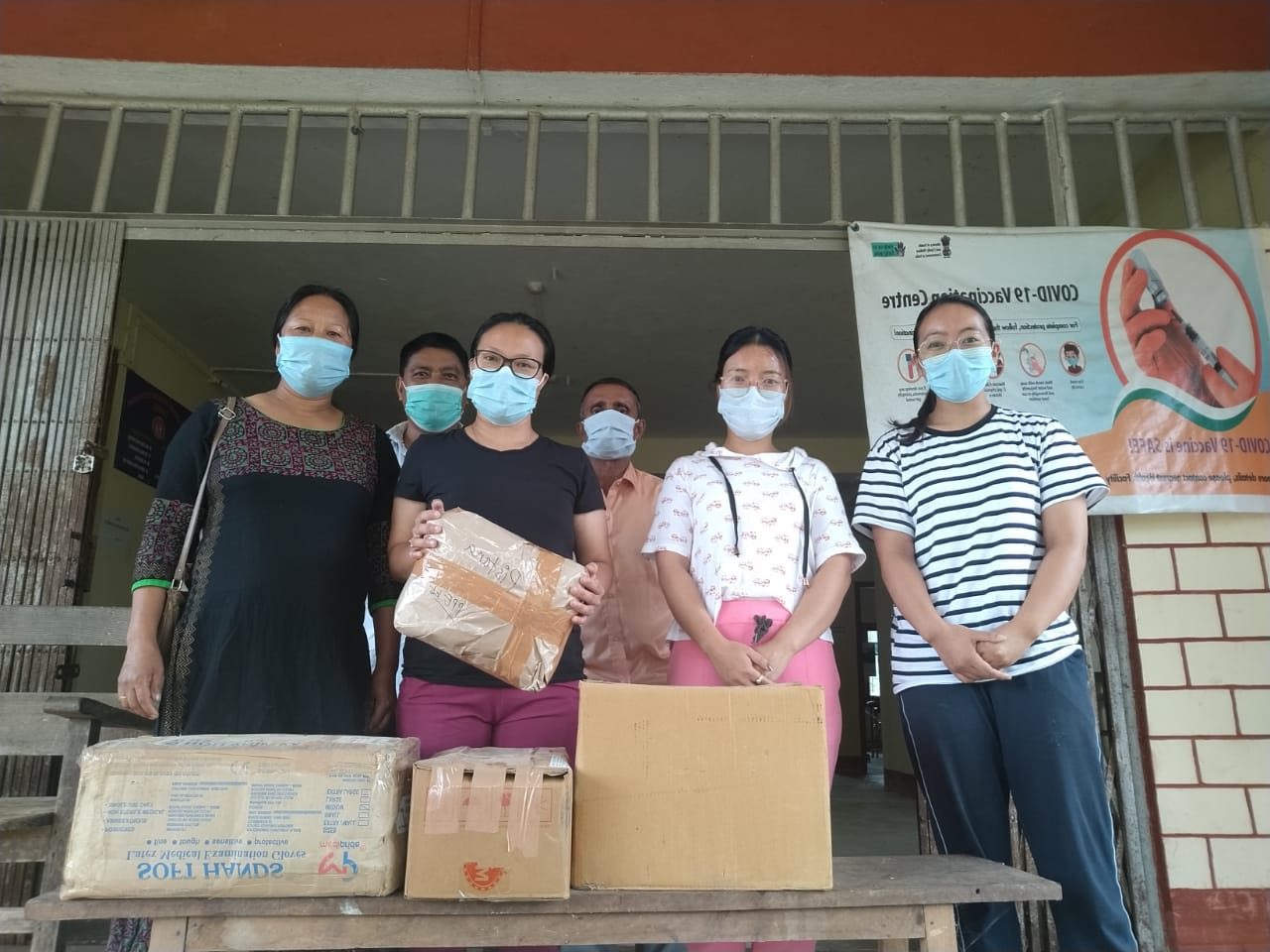


Expenditure
The HNAP model has been designed on the lines of “shared parenting” where three sets of parents protect hornbill nests in the wild. The first set of parents are the biological hornbill parents themselves, the local nest protectors who visit the nests throughout the breeding season and monitor them are the second set of parents and the donors from across the world who adopt these nests are the third set of hornbill parents. The donations and support received from our hornbill parents have helped sustain this program successfully since its inception. Since 2013-14, we have also been receiving donations from zoos abroad.
The funds that we raise go towards paying salaries of the nest protectors, local field coordinator, and project co-ordinator, purchase of field equipment, medical emergencies and running costs such as fuel. A proportion of the fund is used annually for the welfare of the local community based on the availability of funds. In 2020 and 2021, we focused on assisting the administration and the local community health care centre in dealing with the Covid pandemic.
The table below lists our donations and expenses from October 2020 to September 2021.
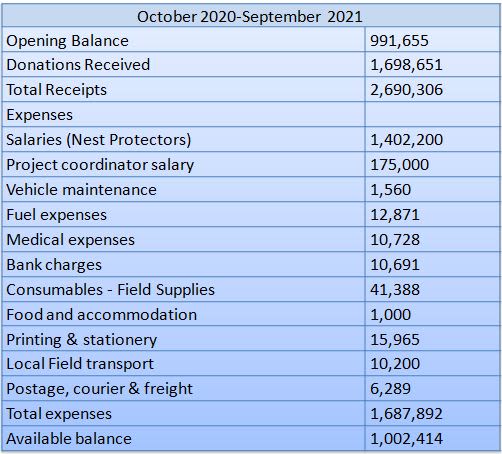
Acknowledgements
We are extremely grateful to all the hornbill parents, zoos, Arunachal Pradesh Forest Department and the Serenity Trust for making it possible for us to implement all the conservation activities. We thank Nature in Focus (NiF), Radha Rangarajan and Arati Kumar-Rao for helping us raise funds for the nest adoption program through their network .
We thank the Vivekananda Kendriya Vidyalaya Alumni Association, Pakke Kessang district unit (VKVAAPKD), Jorjo Tana, Basang Wage, Vikram Tayam, for support and help. We also thank Nandita Hazarika and Goutam Narayan for their continued support to the program.
We thank the Forest Department and staff of Papum Reserved Forest, Pakke Tiger Reserve, Buxa Tiger Reserve and Dihing- Patkai landscape for their support towards the hornbill research and conservation efforts in these landscapes. We also thank our collaborating partners in each of these landscapes.
We thank NCF's admin and accounts team – Smita Prabhakar, Vinay Hegde, M. Shivakumar, for their efficiency in the admin and accounts handling. We thank Veena Rai for her critical assistance and support in the Eastern Himalaya program and for the HNAP till March 2021. We are grateful to Dr. Divya Mudappa for her help in fund-raising for the HNAP.
We are also grateful to our colleagues in NCF’s Eastern Himalaya program: Rohit Naniwadekar, Saniya Chaplod, Noopur Borawake, Bibidishananda Basu, Late Kumar Thapa, Khem Thapa, Tali Nabum, Sagar Kino, Arjun Rai, Sital Dako, Narayan Mogar, Yaha Chiri, Bhaskar Bora, Dhruba Sonowal, Nayan Khakhlari, Dollar Ganguly, Sitaram Mahato and Kezajacho Dukpa for their help and support in many ways.
The HNAP is possible due to the dedication and effort of our team of nest protectors. We express our gratitude to all the past nest protectors for building a strong foundation and the current team which consist of Tajik Tachang, local co-ordinator, and nest protectors - Budhiram Tai, Kaja Keyang, Naga Kino, Nikje Tayem, Prem Tok, Rikum Gyadi, Sako Waru, Tajek Wage, Taring Tachang and Vijay Tachang– for supporting hornbill conservation in this landscape.
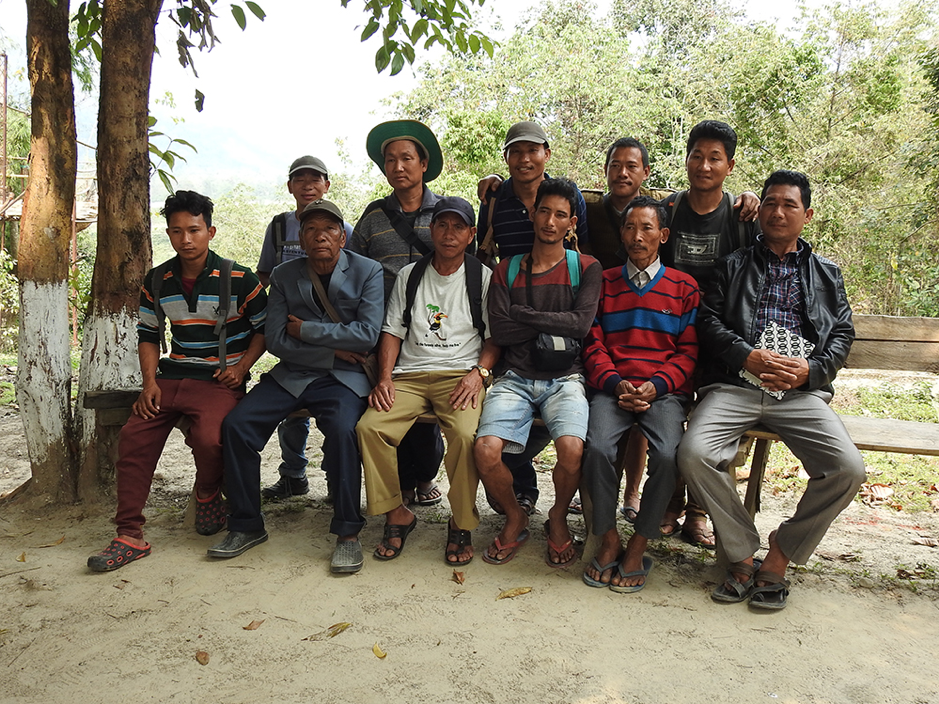
Credits
Cover image : Saniya Chaplod
Photo credits: Aparajita Datta, Arjun Rai, Bhaskar Bora, Dollar Ganguly, Kalyan Varma, Karishma Pradhan, Kezajacho Dukpa, Khem Thapa, Noopur Borawake, Prem Tok, Rohit Naniwadekar, Sagar Kino, Saniya Chaplod, Sitaram Mahato and Vijay Tachang
Video credit: Sagar Kino
Illustration: Arjun Srivathsa
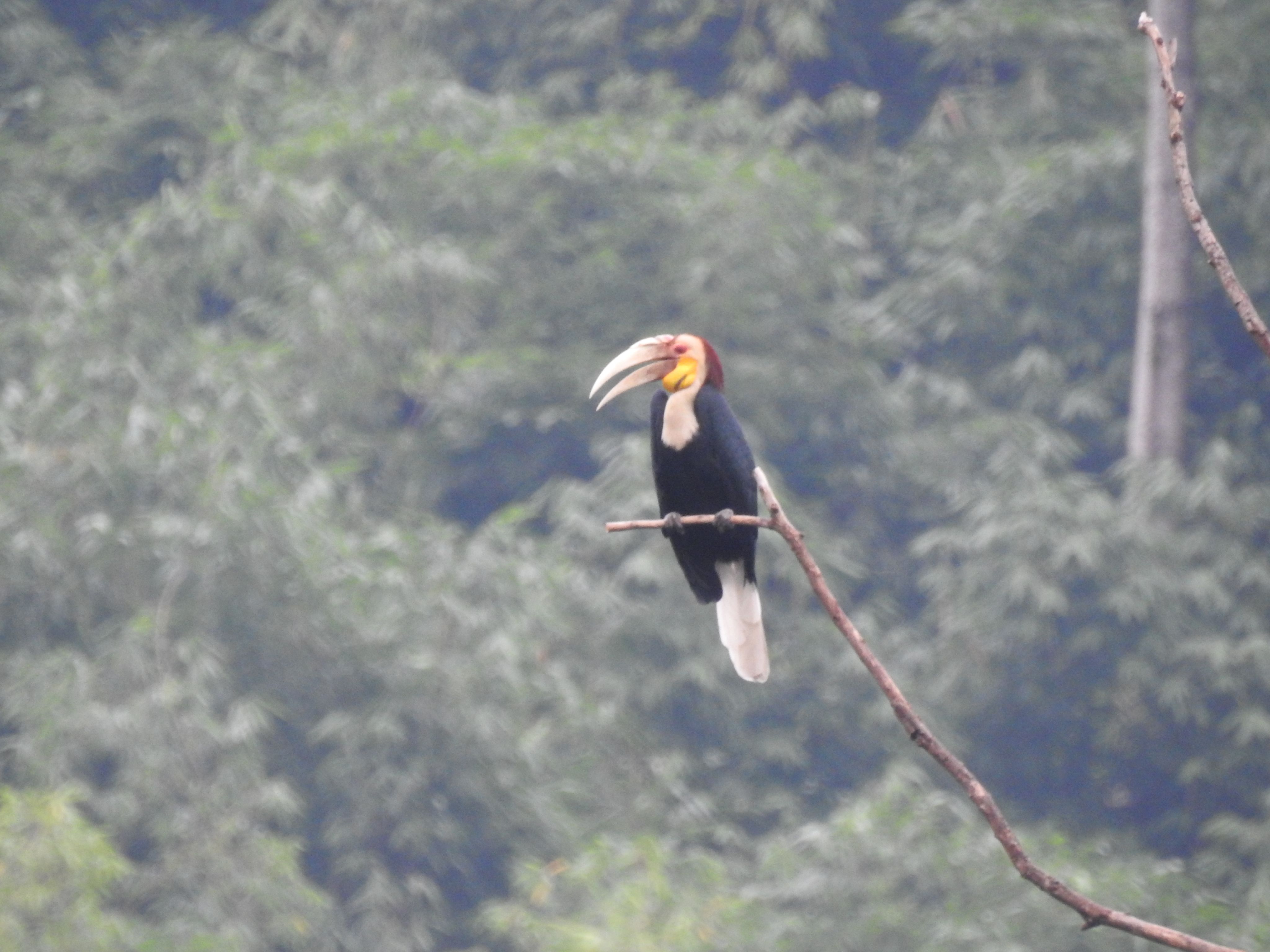
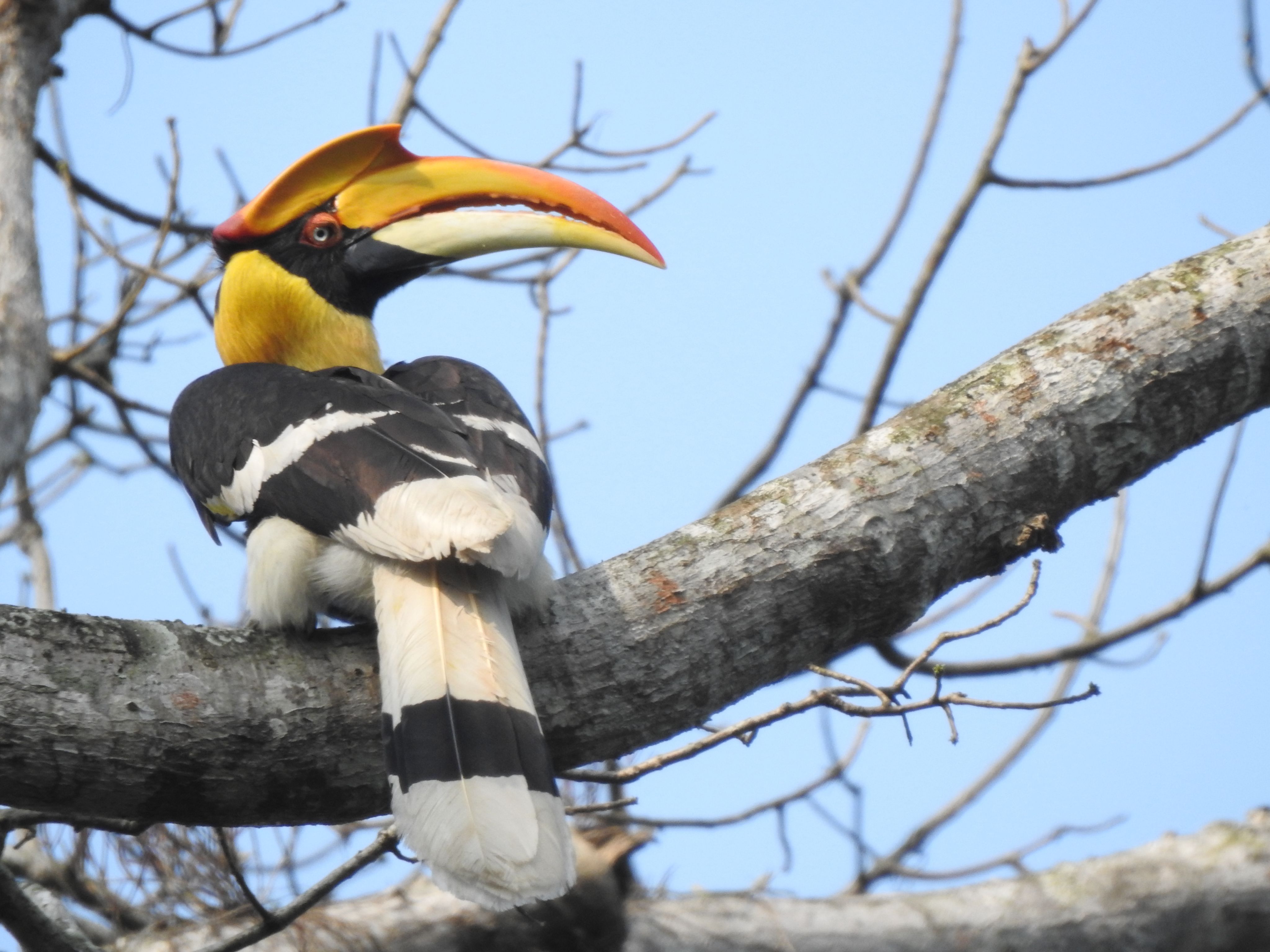
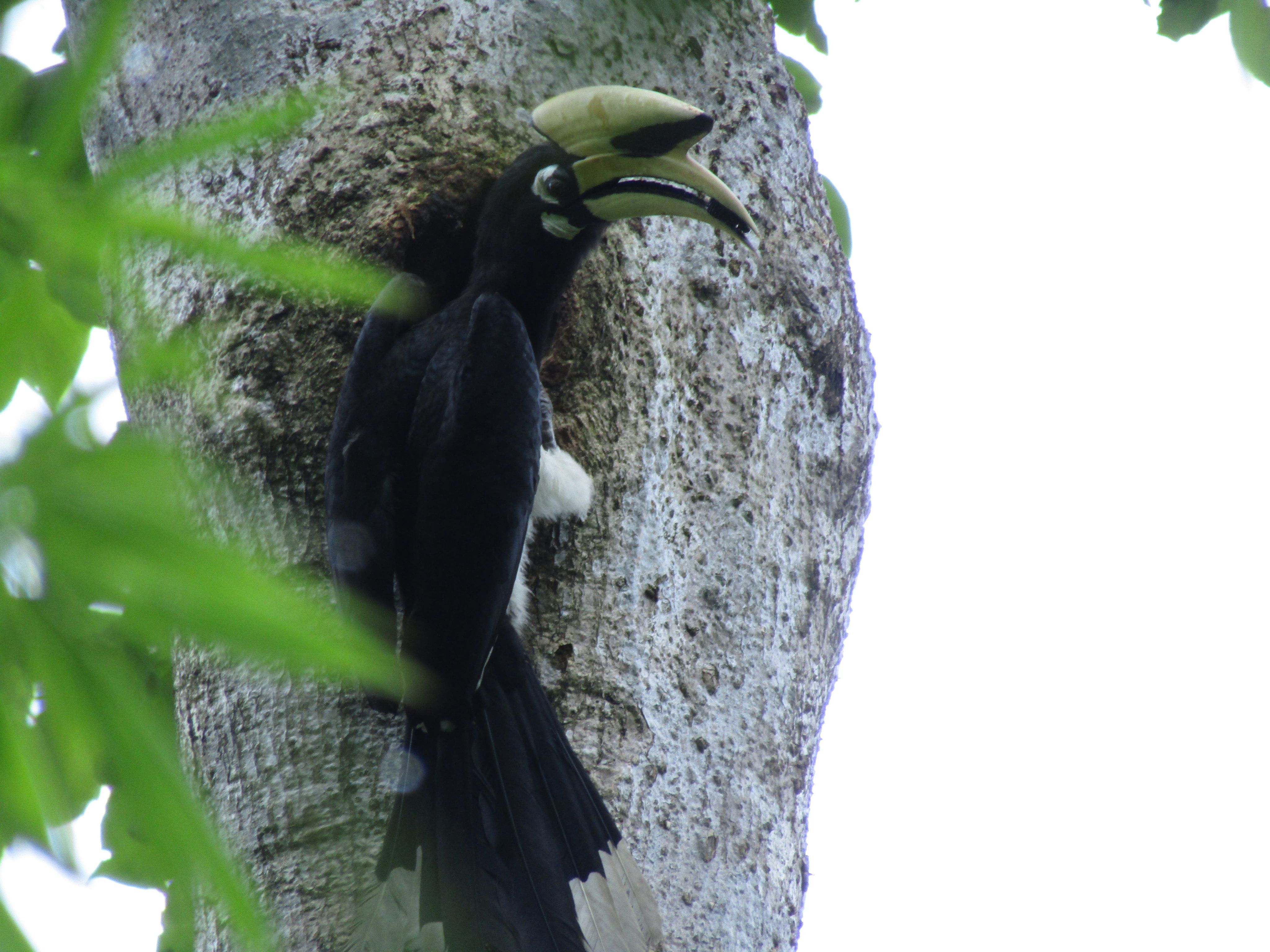
Hornbill parents
Listed below are all donors who have adopted hornbill nests from October 2020 - September 2021. We thank you for your support towards protecting hornbills. If you wish to adopt a hornbill nest again, you can do so online using this link http://ncf-india.org/pages/donate. Donations by Indian donors are eligible for tax exemption under Sec. 80(G) (50% exemption) or Sec. 35 (150% exemption) of the Income Tax Act. Foreign nationals can write to karishma@ncf-india.org or smita@ncf-india.org for details to donate under the FCRA.
Please do send us an email at karishma@ncf-india.org to let us know after you have donated so that we can contact you and keep you updated on our work.
1. Aditi Puri
2. Aishwarya Mandya
3. Akshaa Vatwani
4. Akshay Panday
5. Amruth Anand
6. Anjali Powar Haridass
7. Anushri Karve
8. Aparajita Datta
9. Arindam Ray
10. Arjan Roy
11. Arun Shekhar
12. Arvind Datar
13. Ashwani Sharma
14. Ashwin Baindur
15. Ashwini Kumar Bhat
16. Astha Gautam
17. Charudutt Mishra
18. Dhruvin Acharya
19. Diana Philip
20. Eashwar Raghurama
21. Geetha Subramanian
22. Hema Maira
23. Jagadeeshwaran Ganapathy
24. Janhvi Vyas
25. Jessu Anand
26. Jyotsana Nirula
27. Kalyan Varma
28. Kaushani Das
29. Kulsum Rashid
30. M. Gopa Kumar
31. Madhushree Baliga
32. Maitreya Sukumar
33. Margaret Kinnaird and Tim O'Brien
34. Marisha Karwa
35. Medha Darshani
36. Narayan Kumar Dhar
37. Novita Singh
38. Peeyush Sekhsaria
39. Priyanka Pradhan
40. Radha Rangarajan
41. Rajeshwari Ramachandran
42. Ram Gopalakrishnan
43. Rashmitha Tulabandula Juvvadi
44. Rathika Ramasamy
45. Rishabh Lohia
46. Rohan Randery
47. S. Subramanya
48. Sahana Balkal
49. Shalini Singh
50. Siddharth Prasad
51. Sudip Datta
52. Swetha Ponnekanti
53. Tanveen Randhawa
54. Udain Singh Tomar
55. Uday Kumar
56. Ulhas Anand
57. Usha Baliga
58. V Mythili Sharan
59. Vamsi Rao
60. Vinay Nandakumar
61. Vineet Dravid
Zoos that donated towards the Hornbill Nest Adoption Program from Oct 2020- Sept 2021.
1. Rotterdam Zoo
2. Amiens Zoo (Tresorerie Du Grand)
3. American Association of Zookeepers (Nashville Zoo)
4. St. Augustine Alligator Farm Zoological Park
We express our heartfelt gratitude to all the individual and institutional donors who have supported this program and helped sustain it for over 10 years now.
Publications
Naniwadekar, R., Rathore, A., Shukla, U., and Datta, A. 2021. Roost site use by Great (Buceros bicornis) and Wreathed (Rhyticeros undulatus) Hornbill and its implications for seed dispersal. Biotropica https://doi.org/10.1111/btp.13039.
Naniwadekar, R., Mishra, C., Isvaran, K., and Datta, A. 2021. Gardeners of the forest: hornbills govern the spatial distribution of large seeds. Journal of Avian Biology https://doi.org/10.1111/jav.02748.
Borawake, N., Datta, A. & Naniwadekar, R. (2021).Tropical forest restoration in the Eastern Himalaya: Evaluating early survival and growth of native tree species. Ecological Restoration, 39 (3), 52-63. https://doi:10.3368/er.39.3.194
Thank you for reading the HNAP 2021 annual report.
We look forward to your continued support to the Hornbill Nest Adoption Program (HNAP).
Do write to us at: hnap@ncf-india.org or karishma@ncf-india.org.
For more information/updates:
Website : https://www.ncf-india.org/eastern-himalaya/hornbill-nest-adoption-program
Facebook: Hornbill Conservation Program NE India
Instagram: easternhimalaya.ncf
